Assignment On The Dissertation
VerifiedAdded on 2022/09/21
|29
|6957
|22
Assignment
AI Summary
Contribute Materials
Your contribution can guide someone’s learning journey. Share your
documents today.

Running head: DISSERTATION
DISSERTATION
Name of the Student:
Name of the University:
Author Note:
DISSERTATION
Name of the Student:
Name of the University:
Author Note:
Secure Best Marks with AI Grader
Need help grading? Try our AI Grader for instant feedback on your assignments.
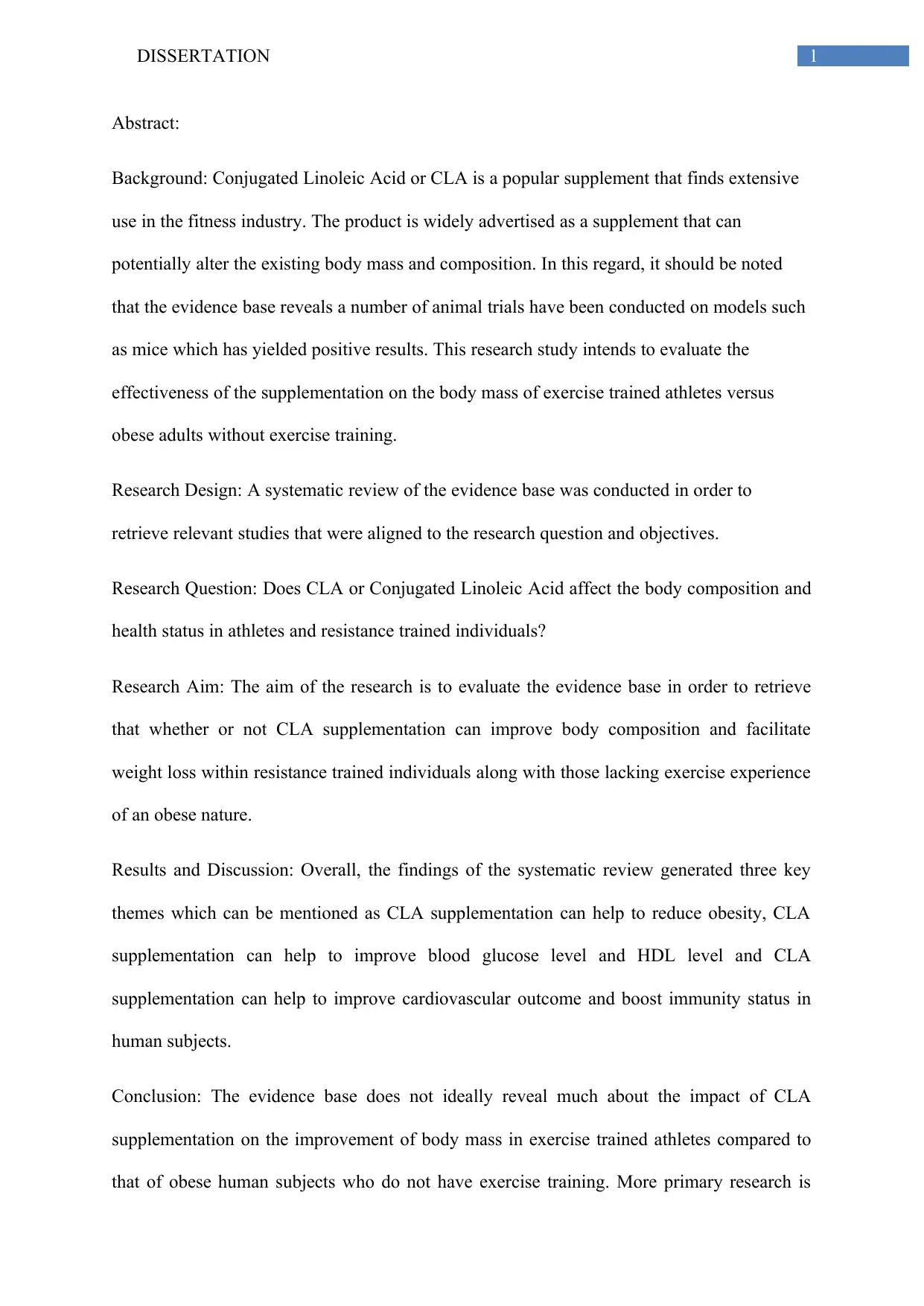
1DISSERTATION
Abstract:
Background: Conjugated Linoleic Acid or CLA is a popular supplement that finds extensive
use in the fitness industry. The product is widely advertised as a supplement that can
potentially alter the existing body mass and composition. In this regard, it should be noted
that the evidence base reveals a number of animal trials have been conducted on models such
as mice which has yielded positive results. This research study intends to evaluate the
effectiveness of the supplementation on the body mass of exercise trained athletes versus
obese adults without exercise training.
Research Design: A systematic review of the evidence base was conducted in order to
retrieve relevant studies that were aligned to the research question and objectives.
Research Question: Does CLA or Conjugated Linoleic Acid affect the body composition and
health status in athletes and resistance trained individuals?
Research Aim: The aim of the research is to evaluate the evidence base in order to retrieve
that whether or not CLA supplementation can improve body composition and facilitate
weight loss within resistance trained individuals along with those lacking exercise experience
of an obese nature.
Results and Discussion: Overall, the findings of the systematic review generated three key
themes which can be mentioned as CLA supplementation can help to reduce obesity, CLA
supplementation can help to improve blood glucose level and HDL level and CLA
supplementation can help to improve cardiovascular outcome and boost immunity status in
human subjects.
Conclusion: The evidence base does not ideally reveal much about the impact of CLA
supplementation on the improvement of body mass in exercise trained athletes compared to
that of obese human subjects who do not have exercise training. More primary research is
Abstract:
Background: Conjugated Linoleic Acid or CLA is a popular supplement that finds extensive
use in the fitness industry. The product is widely advertised as a supplement that can
potentially alter the existing body mass and composition. In this regard, it should be noted
that the evidence base reveals a number of animal trials have been conducted on models such
as mice which has yielded positive results. This research study intends to evaluate the
effectiveness of the supplementation on the body mass of exercise trained athletes versus
obese adults without exercise training.
Research Design: A systematic review of the evidence base was conducted in order to
retrieve relevant studies that were aligned to the research question and objectives.
Research Question: Does CLA or Conjugated Linoleic Acid affect the body composition and
health status in athletes and resistance trained individuals?
Research Aim: The aim of the research is to evaluate the evidence base in order to retrieve
that whether or not CLA supplementation can improve body composition and facilitate
weight loss within resistance trained individuals along with those lacking exercise experience
of an obese nature.
Results and Discussion: Overall, the findings of the systematic review generated three key
themes which can be mentioned as CLA supplementation can help to reduce obesity, CLA
supplementation can help to improve blood glucose level and HDL level and CLA
supplementation can help to improve cardiovascular outcome and boost immunity status in
human subjects.
Conclusion: The evidence base does not ideally reveal much about the impact of CLA
supplementation on the improvement of body mass in exercise trained athletes compared to
that of obese human subjects who do not have exercise training. More primary research is

2DISSERTATION
required on the effectiveness of the supplementation to back the claim and appropriately
answer the research question.
required on the effectiveness of the supplementation to back the claim and appropriately
answer the research question.
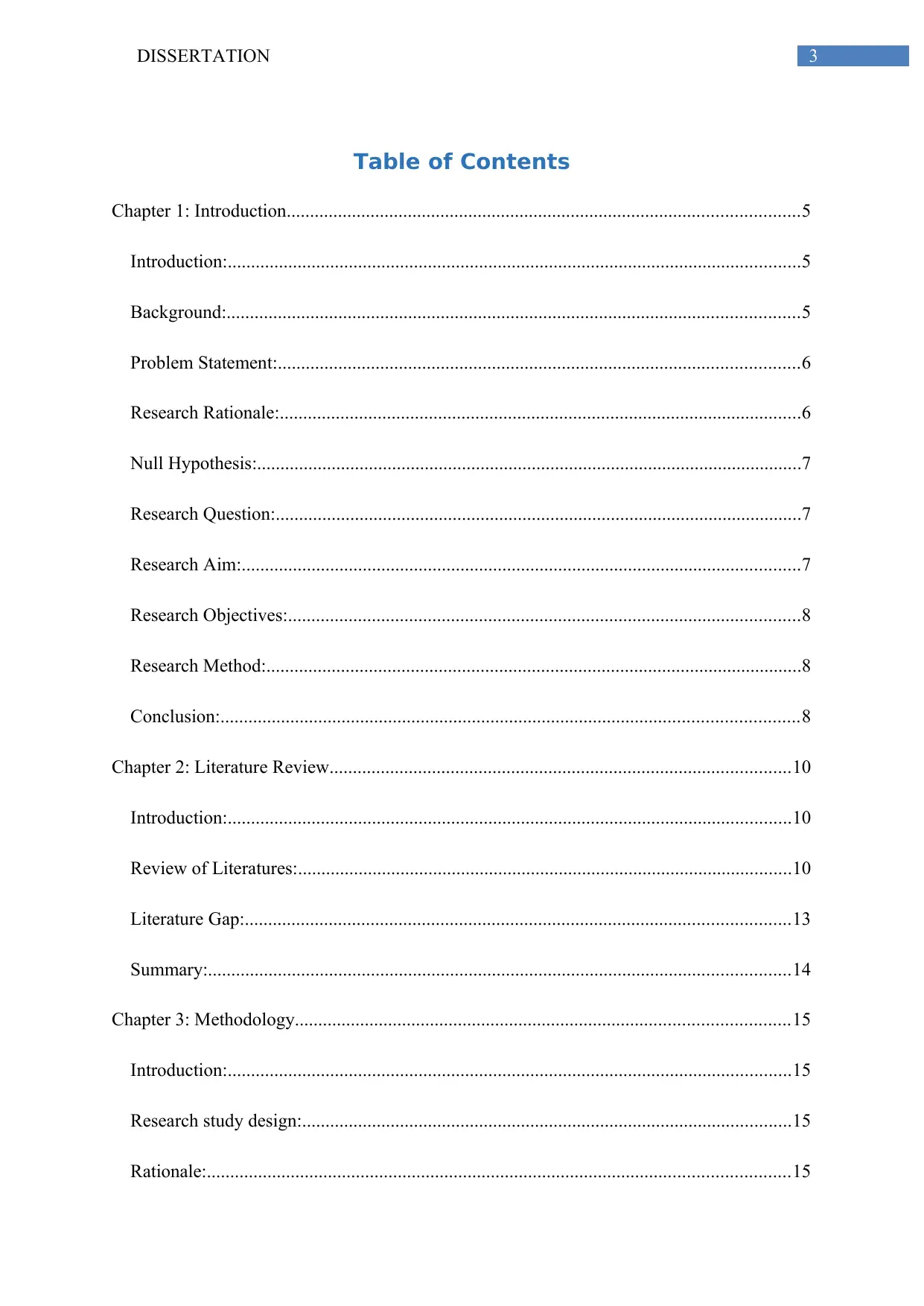
3DISSERTATION
Table of Contents
Chapter 1: Introduction..............................................................................................................5
Introduction:...........................................................................................................................5
Background:...........................................................................................................................5
Problem Statement:................................................................................................................6
Research Rationale:................................................................................................................6
Null Hypothesis:.....................................................................................................................7
Research Question:.................................................................................................................7
Research Aim:........................................................................................................................7
Research Objectives:..............................................................................................................8
Research Method:...................................................................................................................8
Conclusion:............................................................................................................................8
Chapter 2: Literature Review...................................................................................................10
Introduction:.........................................................................................................................10
Review of Literatures:..........................................................................................................10
Literature Gap:.....................................................................................................................13
Summary:.............................................................................................................................14
Chapter 3: Methodology..........................................................................................................15
Introduction:.........................................................................................................................15
Research study design:.........................................................................................................15
Rationale:.............................................................................................................................15
Table of Contents
Chapter 1: Introduction..............................................................................................................5
Introduction:...........................................................................................................................5
Background:...........................................................................................................................5
Problem Statement:................................................................................................................6
Research Rationale:................................................................................................................6
Null Hypothesis:.....................................................................................................................7
Research Question:.................................................................................................................7
Research Aim:........................................................................................................................7
Research Objectives:..............................................................................................................8
Research Method:...................................................................................................................8
Conclusion:............................................................................................................................8
Chapter 2: Literature Review...................................................................................................10
Introduction:.........................................................................................................................10
Review of Literatures:..........................................................................................................10
Literature Gap:.....................................................................................................................13
Summary:.............................................................................................................................14
Chapter 3: Methodology..........................................................................................................15
Introduction:.........................................................................................................................15
Research study design:.........................................................................................................15
Rationale:.............................................................................................................................15
Paraphrase This Document
Need a fresh take? Get an instant paraphrase of this document with our AI Paraphraser
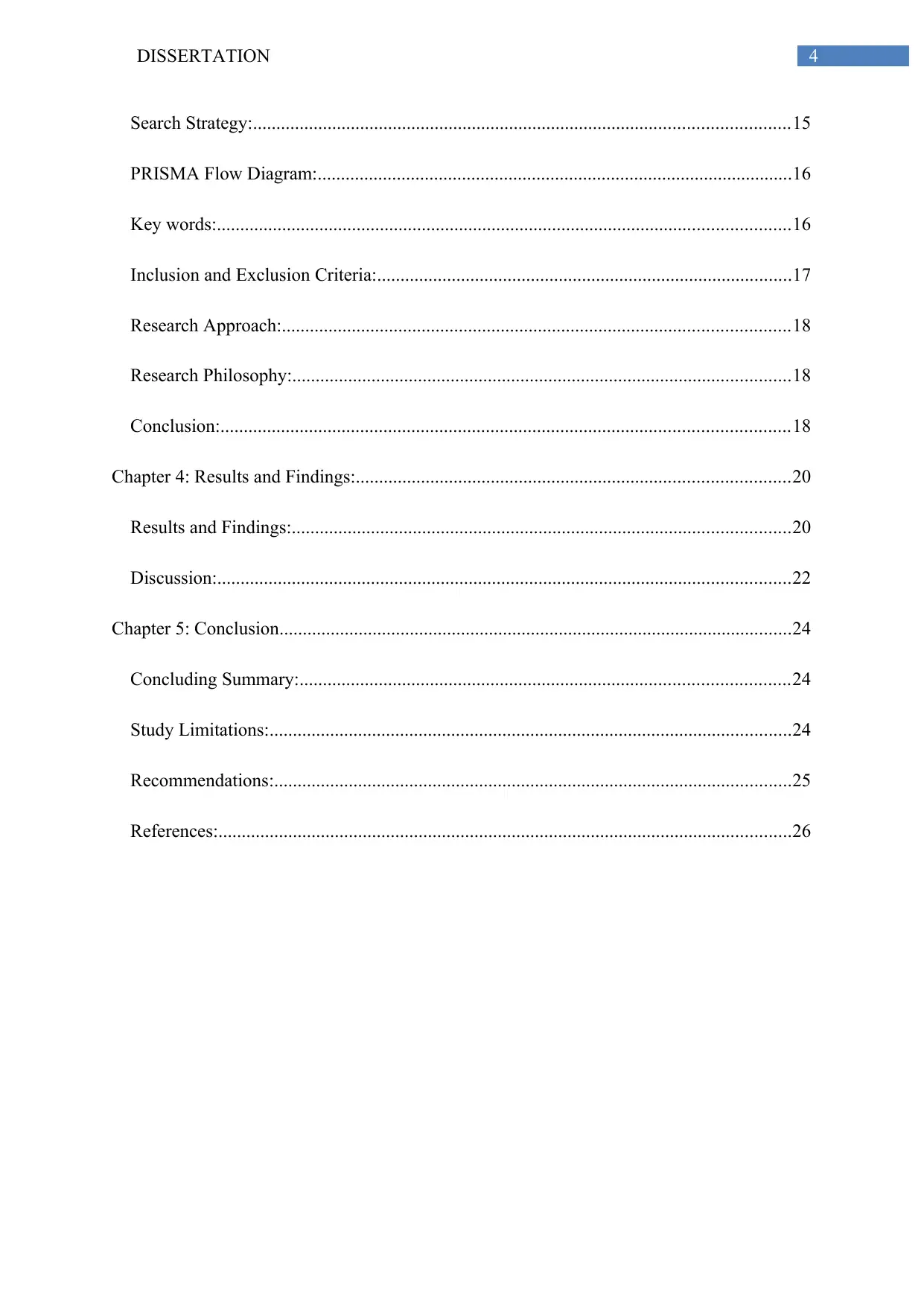
4DISSERTATION
Search Strategy:...................................................................................................................15
PRISMA Flow Diagram:......................................................................................................16
Key words:...........................................................................................................................16
Inclusion and Exclusion Criteria:.........................................................................................17
Research Approach:.............................................................................................................18
Research Philosophy:...........................................................................................................18
Conclusion:..........................................................................................................................18
Chapter 4: Results and Findings:.............................................................................................20
Results and Findings:...........................................................................................................20
Discussion:...........................................................................................................................22
Chapter 5: Conclusion..............................................................................................................24
Concluding Summary:.........................................................................................................24
Study Limitations:................................................................................................................24
Recommendations:...............................................................................................................25
References:...........................................................................................................................26
Search Strategy:...................................................................................................................15
PRISMA Flow Diagram:......................................................................................................16
Key words:...........................................................................................................................16
Inclusion and Exclusion Criteria:.........................................................................................17
Research Approach:.............................................................................................................18
Research Philosophy:...........................................................................................................18
Conclusion:..........................................................................................................................18
Chapter 4: Results and Findings:.............................................................................................20
Results and Findings:...........................................................................................................20
Discussion:...........................................................................................................................22
Chapter 5: Conclusion..............................................................................................................24
Concluding Summary:.........................................................................................................24
Study Limitations:................................................................................................................24
Recommendations:...............................................................................................................25
References:...........................................................................................................................26
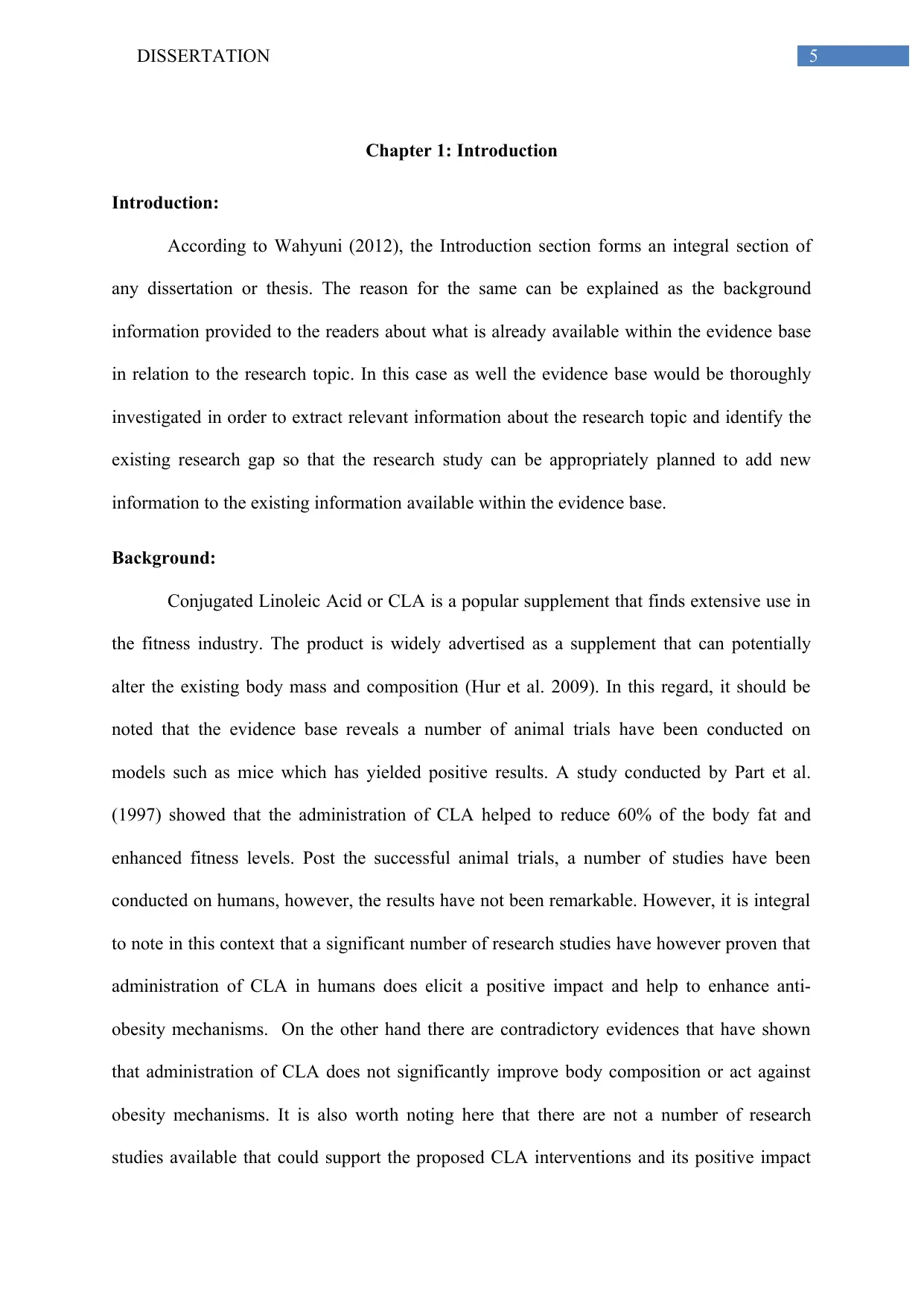
5DISSERTATION
Chapter 1: Introduction
Introduction:
According to Wahyuni (2012), the Introduction section forms an integral section of
any dissertation or thesis. The reason for the same can be explained as the background
information provided to the readers about what is already available within the evidence base
in relation to the research topic. In this case as well the evidence base would be thoroughly
investigated in order to extract relevant information about the research topic and identify the
existing research gap so that the research study can be appropriately planned to add new
information to the existing information available within the evidence base.
Background:
Conjugated Linoleic Acid or CLA is a popular supplement that finds extensive use in
the fitness industry. The product is widely advertised as a supplement that can potentially
alter the existing body mass and composition (Hur et al. 2009). In this regard, it should be
noted that the evidence base reveals a number of animal trials have been conducted on
models such as mice which has yielded positive results. A study conducted by Part et al.
(1997) showed that the administration of CLA helped to reduce 60% of the body fat and
enhanced fitness levels. Post the successful animal trials, a number of studies have been
conducted on humans, however, the results have not been remarkable. However, it is integral
to note in this context that a significant number of research studies have however proven that
administration of CLA in humans does elicit a positive impact and help to enhance anti-
obesity mechanisms. On the other hand there are contradictory evidences that have shown
that administration of CLA does not significantly improve body composition or act against
obesity mechanisms. It is also worth noting here that there are not a number of research
studies available that could support the proposed CLA interventions and its positive impact
Chapter 1: Introduction
Introduction:
According to Wahyuni (2012), the Introduction section forms an integral section of
any dissertation or thesis. The reason for the same can be explained as the background
information provided to the readers about what is already available within the evidence base
in relation to the research topic. In this case as well the evidence base would be thoroughly
investigated in order to extract relevant information about the research topic and identify the
existing research gap so that the research study can be appropriately planned to add new
information to the existing information available within the evidence base.
Background:
Conjugated Linoleic Acid or CLA is a popular supplement that finds extensive use in
the fitness industry. The product is widely advertised as a supplement that can potentially
alter the existing body mass and composition (Hur et al. 2009). In this regard, it should be
noted that the evidence base reveals a number of animal trials have been conducted on
models such as mice which has yielded positive results. A study conducted by Part et al.
(1997) showed that the administration of CLA helped to reduce 60% of the body fat and
enhanced fitness levels. Post the successful animal trials, a number of studies have been
conducted on humans, however, the results have not been remarkable. However, it is integral
to note in this context that a significant number of research studies have however proven that
administration of CLA in humans does elicit a positive impact and help to enhance anti-
obesity mechanisms. On the other hand there are contradictory evidences that have shown
that administration of CLA does not significantly improve body composition or act against
obesity mechanisms. It is also worth noting here that there are not a number of research
studies available that could support the proposed CLA interventions and its positive impact
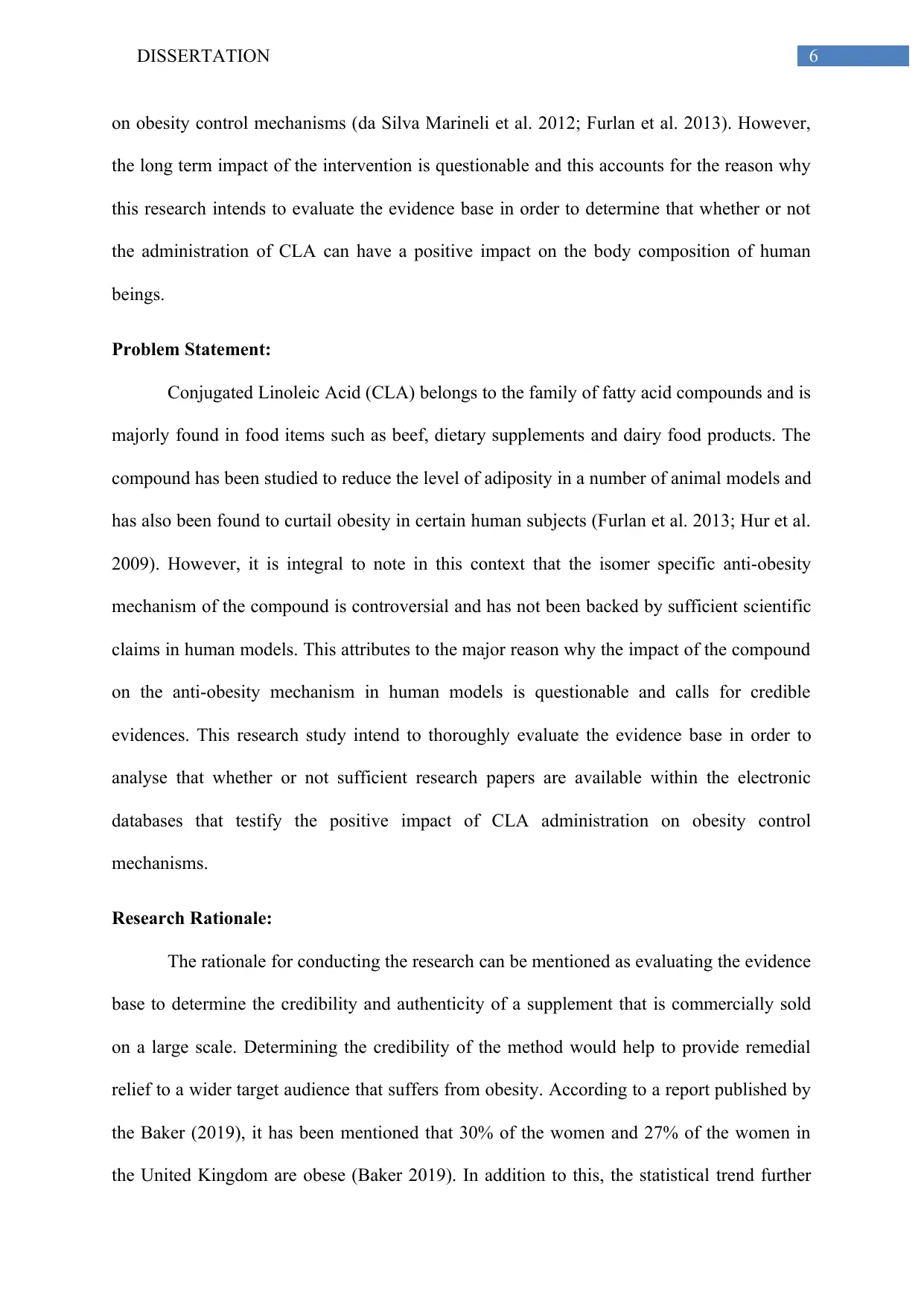
6DISSERTATION
on obesity control mechanisms (da Silva Marineli et al. 2012; Furlan et al. 2013). However,
the long term impact of the intervention is questionable and this accounts for the reason why
this research intends to evaluate the evidence base in order to determine that whether or not
the administration of CLA can have a positive impact on the body composition of human
beings.
Problem Statement:
Conjugated Linoleic Acid (CLA) belongs to the family of fatty acid compounds and is
majorly found in food items such as beef, dietary supplements and dairy food products. The
compound has been studied to reduce the level of adiposity in a number of animal models and
has also been found to curtail obesity in certain human subjects (Furlan et al. 2013; Hur et al.
2009). However, it is integral to note in this context that the isomer specific anti-obesity
mechanism of the compound is controversial and has not been backed by sufficient scientific
claims in human models. This attributes to the major reason why the impact of the compound
on the anti-obesity mechanism in human models is questionable and calls for credible
evidences. This research study intend to thoroughly evaluate the evidence base in order to
analyse that whether or not sufficient research papers are available within the electronic
databases that testify the positive impact of CLA administration on obesity control
mechanisms.
Research Rationale:
The rationale for conducting the research can be mentioned as evaluating the evidence
base to determine the credibility and authenticity of a supplement that is commercially sold
on a large scale. Determining the credibility of the method would help to provide remedial
relief to a wider target audience that suffers from obesity. According to a report published by
the Baker (2019), it has been mentioned that 30% of the women and 27% of the women in
the United Kingdom are obese (Baker 2019). In addition to this, the statistical trend further
on obesity control mechanisms (da Silva Marineli et al. 2012; Furlan et al. 2013). However,
the long term impact of the intervention is questionable and this accounts for the reason why
this research intends to evaluate the evidence base in order to determine that whether or not
the administration of CLA can have a positive impact on the body composition of human
beings.
Problem Statement:
Conjugated Linoleic Acid (CLA) belongs to the family of fatty acid compounds and is
majorly found in food items such as beef, dietary supplements and dairy food products. The
compound has been studied to reduce the level of adiposity in a number of animal models and
has also been found to curtail obesity in certain human subjects (Furlan et al. 2013; Hur et al.
2009). However, it is integral to note in this context that the isomer specific anti-obesity
mechanism of the compound is controversial and has not been backed by sufficient scientific
claims in human models. This attributes to the major reason why the impact of the compound
on the anti-obesity mechanism in human models is questionable and calls for credible
evidences. This research study intend to thoroughly evaluate the evidence base in order to
analyse that whether or not sufficient research papers are available within the electronic
databases that testify the positive impact of CLA administration on obesity control
mechanisms.
Research Rationale:
The rationale for conducting the research can be mentioned as evaluating the evidence
base to determine the credibility and authenticity of a supplement that is commercially sold
on a large scale. Determining the credibility of the method would help to provide remedial
relief to a wider target audience that suffers from obesity. According to a report published by
the Baker (2019), it has been mentioned that 30% of the women and 27% of the women in
the United Kingdom are obese (Baker 2019). In addition to this, the statistical trend further
Secure Best Marks with AI Grader
Need help grading? Try our AI Grader for instant feedback on your assignments.
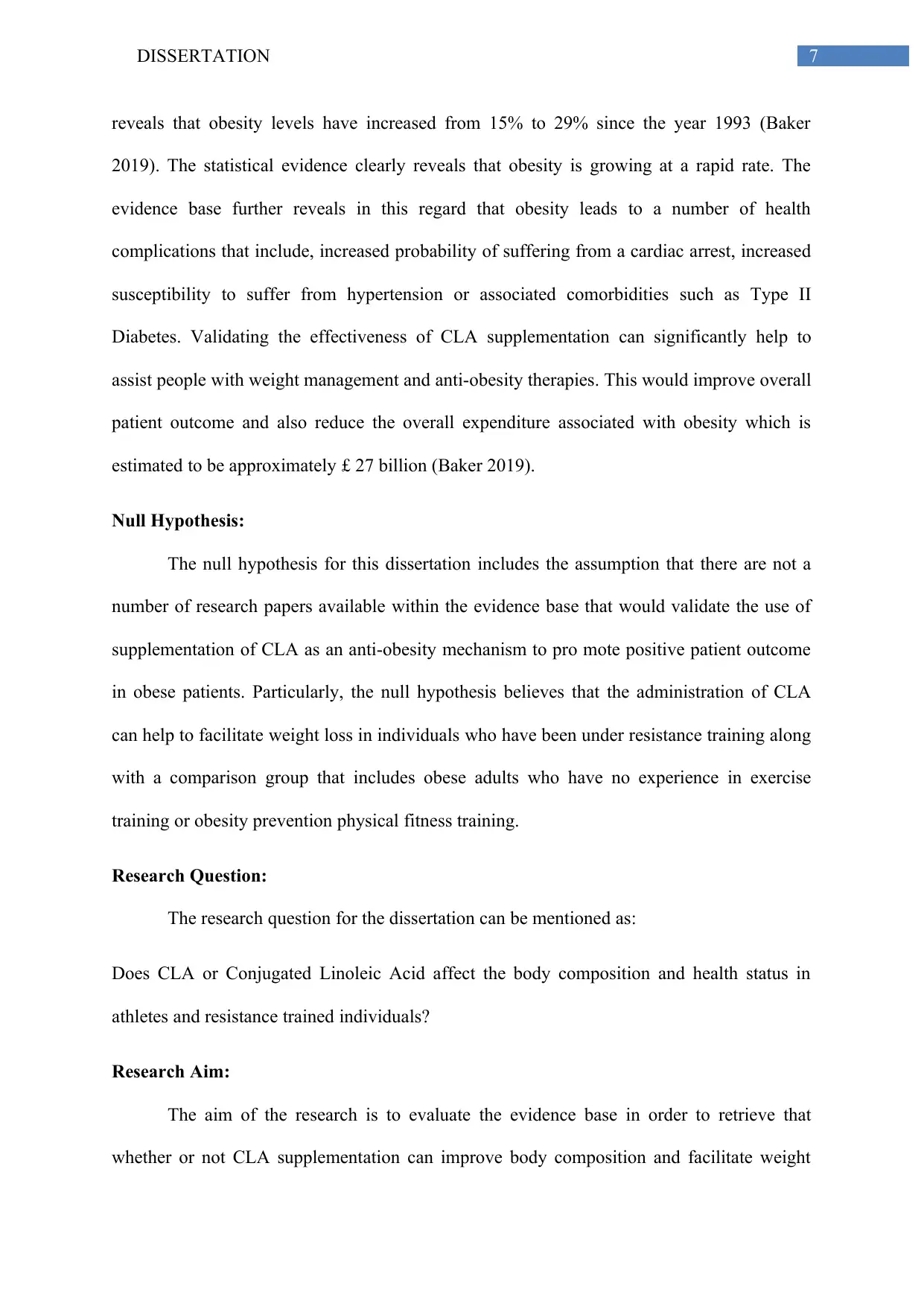
7DISSERTATION
reveals that obesity levels have increased from 15% to 29% since the year 1993 (Baker
2019). The statistical evidence clearly reveals that obesity is growing at a rapid rate. The
evidence base further reveals in this regard that obesity leads to a number of health
complications that include, increased probability of suffering from a cardiac arrest, increased
susceptibility to suffer from hypertension or associated comorbidities such as Type II
Diabetes. Validating the effectiveness of CLA supplementation can significantly help to
assist people with weight management and anti-obesity therapies. This would improve overall
patient outcome and also reduce the overall expenditure associated with obesity which is
estimated to be approximately £ 27 billion (Baker 2019).
Null Hypothesis:
The null hypothesis for this dissertation includes the assumption that there are not a
number of research papers available within the evidence base that would validate the use of
supplementation of CLA as an anti-obesity mechanism to pro mote positive patient outcome
in obese patients. Particularly, the null hypothesis believes that the administration of CLA
can help to facilitate weight loss in individuals who have been under resistance training along
with a comparison group that includes obese adults who have no experience in exercise
training or obesity prevention physical fitness training.
Research Question:
The research question for the dissertation can be mentioned as:
Does CLA or Conjugated Linoleic Acid affect the body composition and health status in
athletes and resistance trained individuals?
Research Aim:
The aim of the research is to evaluate the evidence base in order to retrieve that
whether or not CLA supplementation can improve body composition and facilitate weight
reveals that obesity levels have increased from 15% to 29% since the year 1993 (Baker
2019). The statistical evidence clearly reveals that obesity is growing at a rapid rate. The
evidence base further reveals in this regard that obesity leads to a number of health
complications that include, increased probability of suffering from a cardiac arrest, increased
susceptibility to suffer from hypertension or associated comorbidities such as Type II
Diabetes. Validating the effectiveness of CLA supplementation can significantly help to
assist people with weight management and anti-obesity therapies. This would improve overall
patient outcome and also reduce the overall expenditure associated with obesity which is
estimated to be approximately £ 27 billion (Baker 2019).
Null Hypothesis:
The null hypothesis for this dissertation includes the assumption that there are not a
number of research papers available within the evidence base that would validate the use of
supplementation of CLA as an anti-obesity mechanism to pro mote positive patient outcome
in obese patients. Particularly, the null hypothesis believes that the administration of CLA
can help to facilitate weight loss in individuals who have been under resistance training along
with a comparison group that includes obese adults who have no experience in exercise
training or obesity prevention physical fitness training.
Research Question:
The research question for the dissertation can be mentioned as:
Does CLA or Conjugated Linoleic Acid affect the body composition and health status in
athletes and resistance trained individuals?
Research Aim:
The aim of the research is to evaluate the evidence base in order to retrieve that
whether or not CLA supplementation can improve body composition and facilitate weight
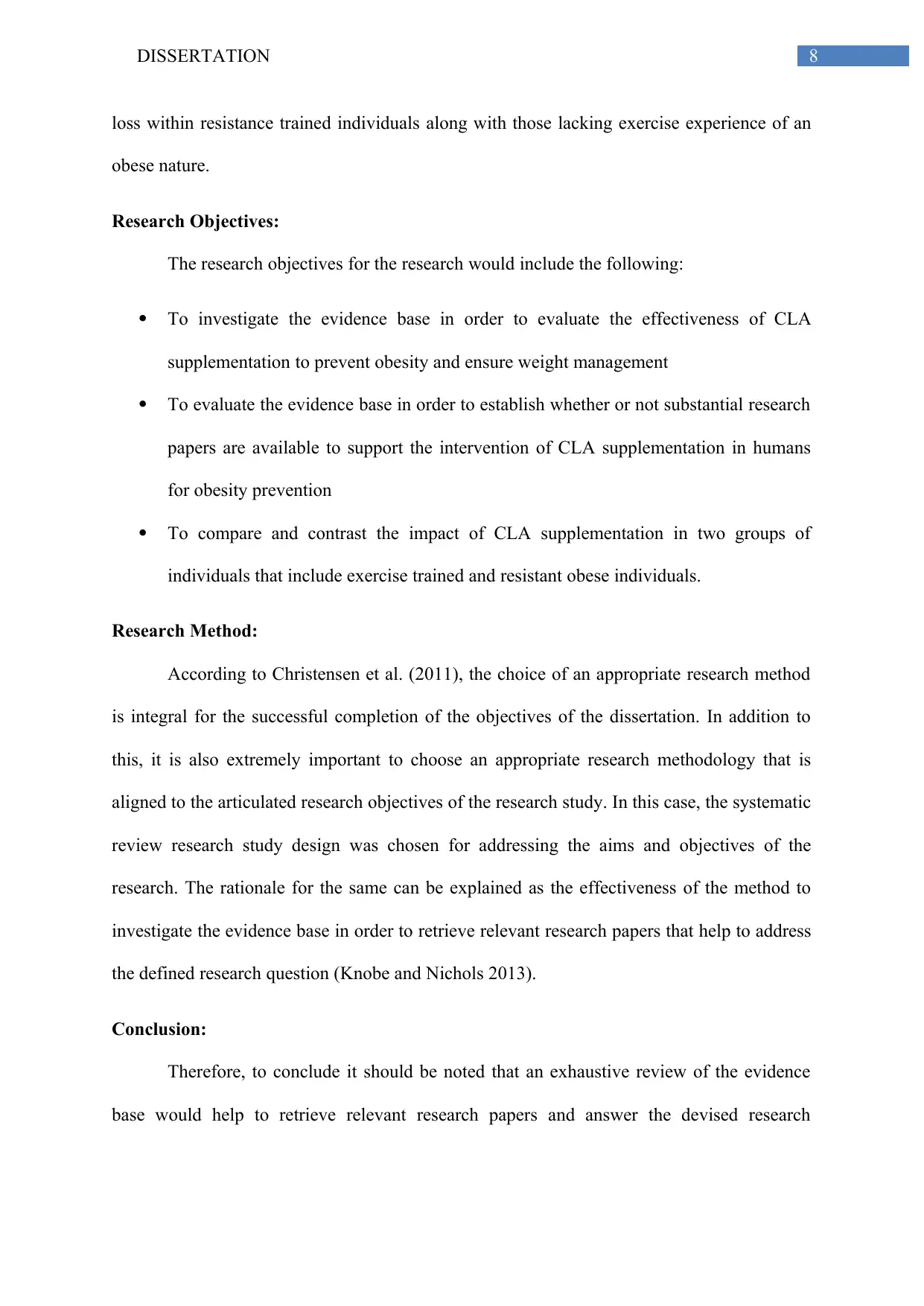
8DISSERTATION
loss within resistance trained individuals along with those lacking exercise experience of an
obese nature.
Research Objectives:
The research objectives for the research would include the following:
To investigate the evidence base in order to evaluate the effectiveness of CLA
supplementation to prevent obesity and ensure weight management
To evaluate the evidence base in order to establish whether or not substantial research
papers are available to support the intervention of CLA supplementation in humans
for obesity prevention
To compare and contrast the impact of CLA supplementation in two groups of
individuals that include exercise trained and resistant obese individuals.
Research Method:
According to Christensen et al. (2011), the choice of an appropriate research method
is integral for the successful completion of the objectives of the dissertation. In addition to
this, it is also extremely important to choose an appropriate research methodology that is
aligned to the articulated research objectives of the research study. In this case, the systematic
review research study design was chosen for addressing the aims and objectives of the
research. The rationale for the same can be explained as the effectiveness of the method to
investigate the evidence base in order to retrieve relevant research papers that help to address
the defined research question (Knobe and Nichols 2013).
Conclusion:
Therefore, to conclude it should be noted that an exhaustive review of the evidence
base would help to retrieve relevant research papers and answer the devised research
loss within resistance trained individuals along with those lacking exercise experience of an
obese nature.
Research Objectives:
The research objectives for the research would include the following:
To investigate the evidence base in order to evaluate the effectiveness of CLA
supplementation to prevent obesity and ensure weight management
To evaluate the evidence base in order to establish whether or not substantial research
papers are available to support the intervention of CLA supplementation in humans
for obesity prevention
To compare and contrast the impact of CLA supplementation in two groups of
individuals that include exercise trained and resistant obese individuals.
Research Method:
According to Christensen et al. (2011), the choice of an appropriate research method
is integral for the successful completion of the objectives of the dissertation. In addition to
this, it is also extremely important to choose an appropriate research methodology that is
aligned to the articulated research objectives of the research study. In this case, the systematic
review research study design was chosen for addressing the aims and objectives of the
research. The rationale for the same can be explained as the effectiveness of the method to
investigate the evidence base in order to retrieve relevant research papers that help to address
the defined research question (Knobe and Nichols 2013).
Conclusion:
Therefore, to conclude it should be noted that an exhaustive review of the evidence
base would help to retrieve relevant research papers and answer the devised research

9DISSERTATION
question. This would further help to identify the existing research gap and help future
researchers to conduct future research studies to bridge the existing literature gap.
question. This would further help to identify the existing research gap and help future
researchers to conduct future research studies to bridge the existing literature gap.
Paraphrase This Document
Need a fresh take? Get an instant paraphrase of this document with our AI Paraphraser
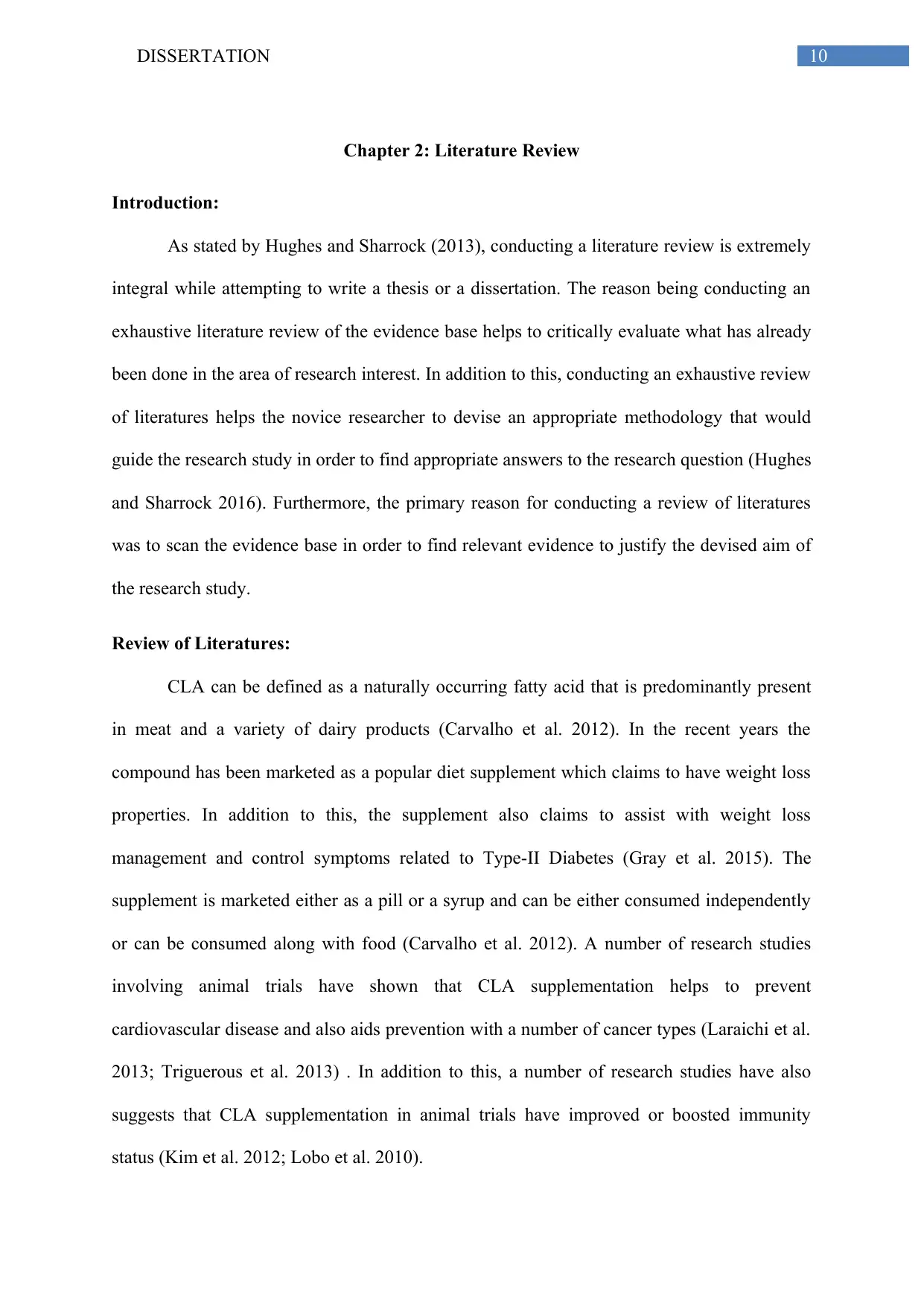
10DISSERTATION
Chapter 2: Literature Review
Introduction:
As stated by Hughes and Sharrock (2013), conducting a literature review is extremely
integral while attempting to write a thesis or a dissertation. The reason being conducting an
exhaustive literature review of the evidence base helps to critically evaluate what has already
been done in the area of research interest. In addition to this, conducting an exhaustive review
of literatures helps the novice researcher to devise an appropriate methodology that would
guide the research study in order to find appropriate answers to the research question (Hughes
and Sharrock 2016). Furthermore, the primary reason for conducting a review of literatures
was to scan the evidence base in order to find relevant evidence to justify the devised aim of
the research study.
Review of Literatures:
CLA can be defined as a naturally occurring fatty acid that is predominantly present
in meat and a variety of dairy products (Carvalho et al. 2012). In the recent years the
compound has been marketed as a popular diet supplement which claims to have weight loss
properties. In addition to this, the supplement also claims to assist with weight loss
management and control symptoms related to Type-II Diabetes (Gray et al. 2015). The
supplement is marketed either as a pill or a syrup and can be either consumed independently
or can be consumed along with food (Carvalho et al. 2012). A number of research studies
involving animal trials have shown that CLA supplementation helps to prevent
cardiovascular disease and also aids prevention with a number of cancer types (Laraichi et al.
2013; Triguerous et al. 2013) . In addition to this, a number of research studies have also
suggests that CLA supplementation in animal trials have improved or boosted immunity
status (Kim et al. 2012; Lobo et al. 2010).
Chapter 2: Literature Review
Introduction:
As stated by Hughes and Sharrock (2013), conducting a literature review is extremely
integral while attempting to write a thesis or a dissertation. The reason being conducting an
exhaustive literature review of the evidence base helps to critically evaluate what has already
been done in the area of research interest. In addition to this, conducting an exhaustive review
of literatures helps the novice researcher to devise an appropriate methodology that would
guide the research study in order to find appropriate answers to the research question (Hughes
and Sharrock 2016). Furthermore, the primary reason for conducting a review of literatures
was to scan the evidence base in order to find relevant evidence to justify the devised aim of
the research study.
Review of Literatures:
CLA can be defined as a naturally occurring fatty acid that is predominantly present
in meat and a variety of dairy products (Carvalho et al. 2012). In the recent years the
compound has been marketed as a popular diet supplement which claims to have weight loss
properties. In addition to this, the supplement also claims to assist with weight loss
management and control symptoms related to Type-II Diabetes (Gray et al. 2015). The
supplement is marketed either as a pill or a syrup and can be either consumed independently
or can be consumed along with food (Carvalho et al. 2012). A number of research studies
involving animal trials have shown that CLA supplementation helps to prevent
cardiovascular disease and also aids prevention with a number of cancer types (Laraichi et al.
2013; Triguerous et al. 2013) . In addition to this, a number of research studies have also
suggests that CLA supplementation in animal trials have improved or boosted immunity
status (Kim et al. 2012; Lobo et al. 2010).
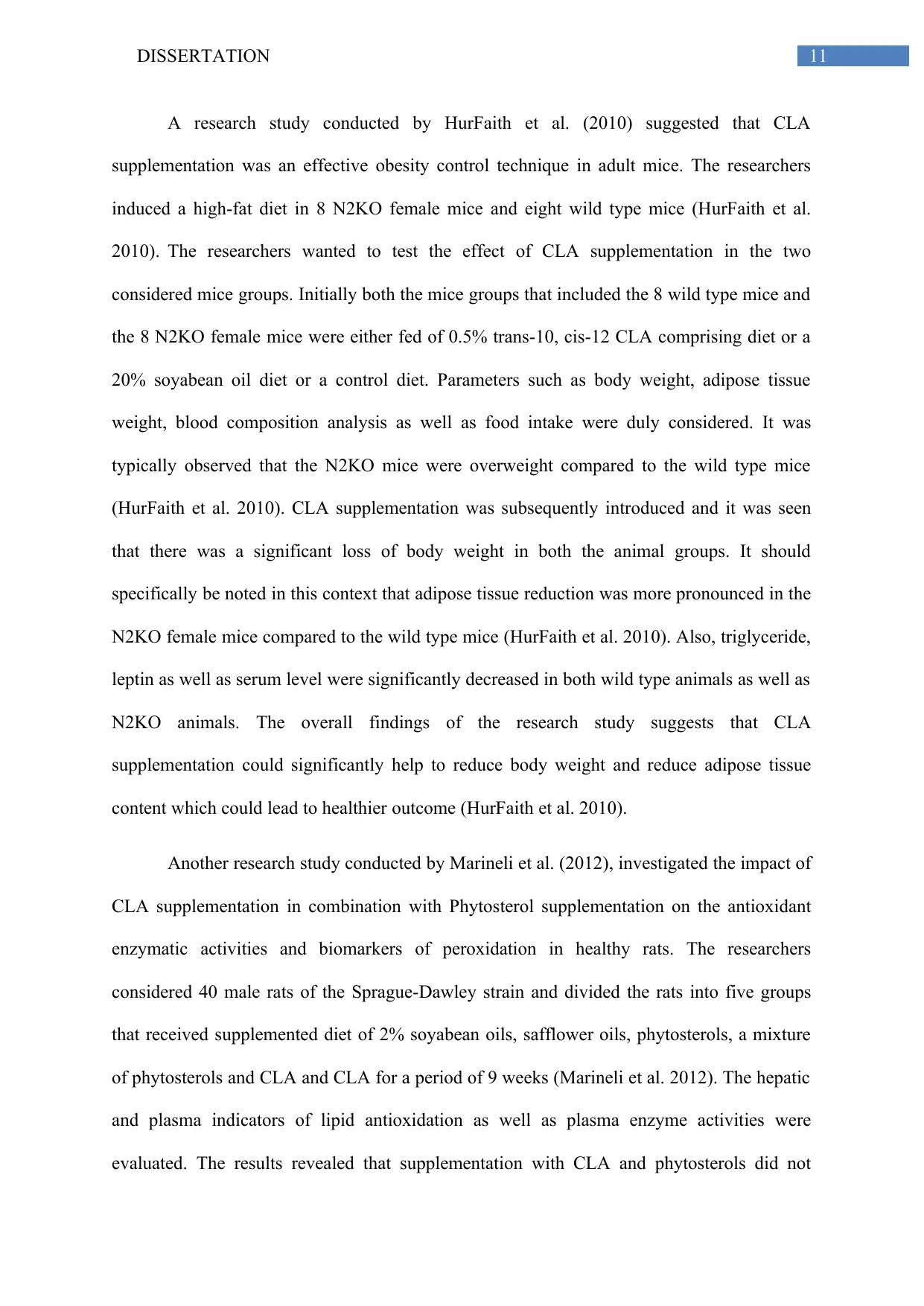
11DISSERTATION
A research study conducted by HurFaith et al. (2010) suggested that CLA
supplementation was an effective obesity control technique in adult mice. The researchers
induced a high-fat diet in 8 N2KO female mice and eight wild type mice (HurFaith et al.
2010). The researchers wanted to test the effect of CLA supplementation in the two
considered mice groups. Initially both the mice groups that included the 8 wild type mice and
the 8 N2KO female mice were either fed of 0.5% trans-10, cis-12 CLA comprising diet or a
20% soyabean oil diet or a control diet. Parameters such as body weight, adipose tissue
weight, blood composition analysis as well as food intake were duly considered. It was
typically observed that the N2KO mice were overweight compared to the wild type mice
(HurFaith et al. 2010). CLA supplementation was subsequently introduced and it was seen
that there was a significant loss of body weight in both the animal groups. It should
specifically be noted in this context that adipose tissue reduction was more pronounced in the
N2KO female mice compared to the wild type mice (HurFaith et al. 2010). Also, triglyceride,
leptin as well as serum level were significantly decreased in both wild type animals as well as
N2KO animals. The overall findings of the research study suggests that CLA
supplementation could significantly help to reduce body weight and reduce adipose tissue
content which could lead to healthier outcome (HurFaith et al. 2010).
Another research study conducted by Marineli et al. (2012), investigated the impact of
CLA supplementation in combination with Phytosterol supplementation on the antioxidant
enzymatic activities and biomarkers of peroxidation in healthy rats. The researchers
considered 40 male rats of the Sprague-Dawley strain and divided the rats into five groups
that received supplemented diet of 2% soyabean oils, safflower oils, phytosterols, a mixture
of phytosterols and CLA and CLA for a period of 9 weeks (Marineli et al. 2012). The hepatic
and plasma indicators of lipid antioxidation as well as plasma enzyme activities were
evaluated. The results revealed that supplementation with CLA and phytosterols did not
A research study conducted by HurFaith et al. (2010) suggested that CLA
supplementation was an effective obesity control technique in adult mice. The researchers
induced a high-fat diet in 8 N2KO female mice and eight wild type mice (HurFaith et al.
2010). The researchers wanted to test the effect of CLA supplementation in the two
considered mice groups. Initially both the mice groups that included the 8 wild type mice and
the 8 N2KO female mice were either fed of 0.5% trans-10, cis-12 CLA comprising diet or a
20% soyabean oil diet or a control diet. Parameters such as body weight, adipose tissue
weight, blood composition analysis as well as food intake were duly considered. It was
typically observed that the N2KO mice were overweight compared to the wild type mice
(HurFaith et al. 2010). CLA supplementation was subsequently introduced and it was seen
that there was a significant loss of body weight in both the animal groups. It should
specifically be noted in this context that adipose tissue reduction was more pronounced in the
N2KO female mice compared to the wild type mice (HurFaith et al. 2010). Also, triglyceride,
leptin as well as serum level were significantly decreased in both wild type animals as well as
N2KO animals. The overall findings of the research study suggests that CLA
supplementation could significantly help to reduce body weight and reduce adipose tissue
content which could lead to healthier outcome (HurFaith et al. 2010).
Another research study conducted by Marineli et al. (2012), investigated the impact of
CLA supplementation in combination with Phytosterol supplementation on the antioxidant
enzymatic activities and biomarkers of peroxidation in healthy rats. The researchers
considered 40 male rats of the Sprague-Dawley strain and divided the rats into five groups
that received supplemented diet of 2% soyabean oils, safflower oils, phytosterols, a mixture
of phytosterols and CLA and CLA for a period of 9 weeks (Marineli et al. 2012). The hepatic
and plasma indicators of lipid antioxidation as well as plasma enzyme activities were
evaluated. The results revealed that supplementation with CLA and phytosterols did not
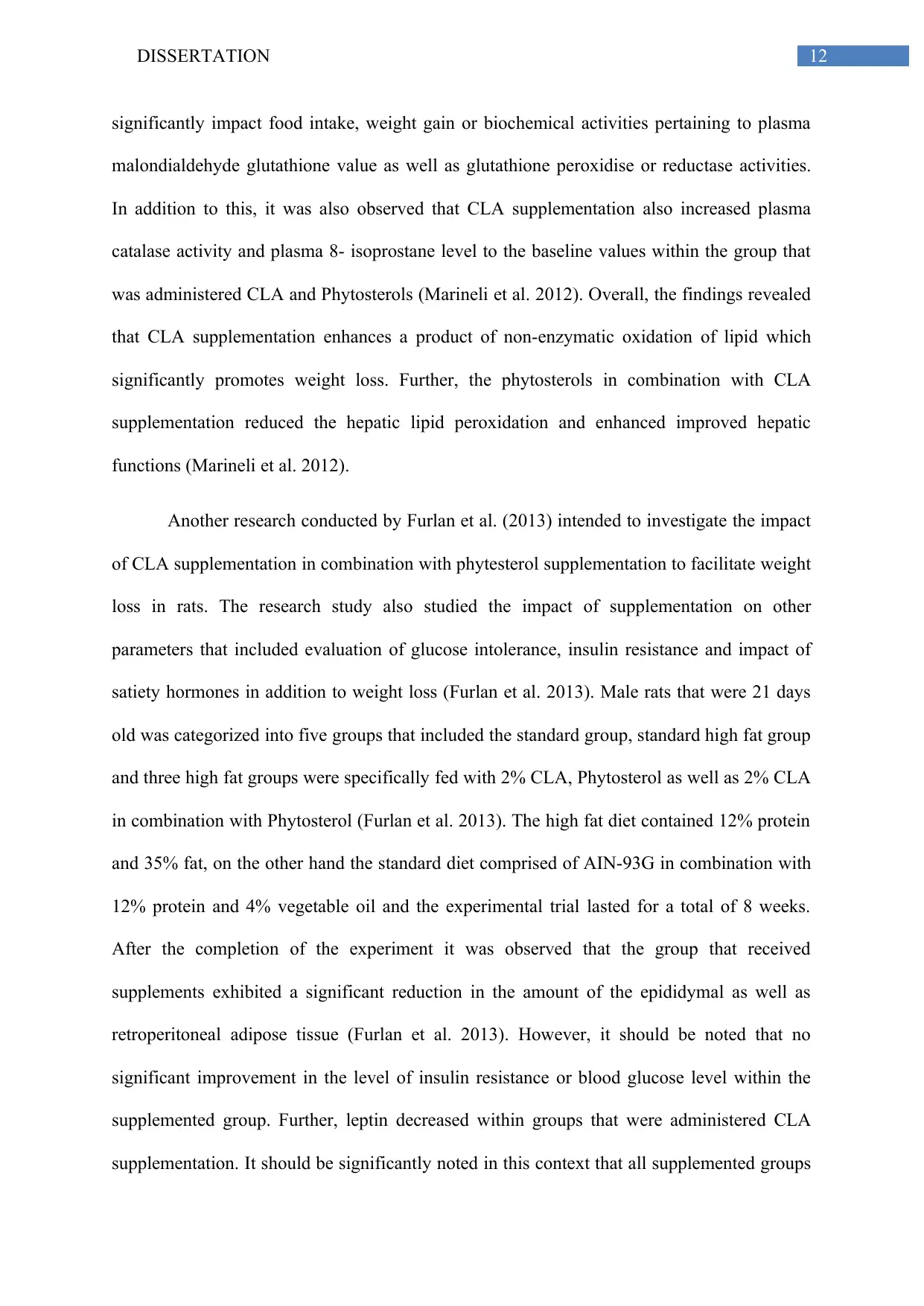
12DISSERTATION
significantly impact food intake, weight gain or biochemical activities pertaining to plasma
malondialdehyde glutathione value as well as glutathione peroxidise or reductase activities.
In addition to this, it was also observed that CLA supplementation also increased plasma
catalase activity and plasma 8- isoprostane level to the baseline values within the group that
was administered CLA and Phytosterols (Marineli et al. 2012). Overall, the findings revealed
that CLA supplementation enhances a product of non-enzymatic oxidation of lipid which
significantly promotes weight loss. Further, the phytosterols in combination with CLA
supplementation reduced the hepatic lipid peroxidation and enhanced improved hepatic
functions (Marineli et al. 2012).
Another research conducted by Furlan et al. (2013) intended to investigate the impact
of CLA supplementation in combination with phytesterol supplementation to facilitate weight
loss in rats. The research study also studied the impact of supplementation on other
parameters that included evaluation of glucose intolerance, insulin resistance and impact of
satiety hormones in addition to weight loss (Furlan et al. 2013). Male rats that were 21 days
old was categorized into five groups that included the standard group, standard high fat group
and three high fat groups were specifically fed with 2% CLA, Phytosterol as well as 2% CLA
in combination with Phytosterol (Furlan et al. 2013). The high fat diet contained 12% protein
and 35% fat, on the other hand the standard diet comprised of AIN-93G in combination with
12% protein and 4% vegetable oil and the experimental trial lasted for a total of 8 weeks.
After the completion of the experiment it was observed that the group that received
supplements exhibited a significant reduction in the amount of the epididymal as well as
retroperitoneal adipose tissue (Furlan et al. 2013). However, it should be noted that no
significant improvement in the level of insulin resistance or blood glucose level within the
supplemented group. Further, leptin decreased within groups that were administered CLA
supplementation. It should be significantly noted in this context that all supplemented groups
significantly impact food intake, weight gain or biochemical activities pertaining to plasma
malondialdehyde glutathione value as well as glutathione peroxidise or reductase activities.
In addition to this, it was also observed that CLA supplementation also increased plasma
catalase activity and plasma 8- isoprostane level to the baseline values within the group that
was administered CLA and Phytosterols (Marineli et al. 2012). Overall, the findings revealed
that CLA supplementation enhances a product of non-enzymatic oxidation of lipid which
significantly promotes weight loss. Further, the phytosterols in combination with CLA
supplementation reduced the hepatic lipid peroxidation and enhanced improved hepatic
functions (Marineli et al. 2012).
Another research conducted by Furlan et al. (2013) intended to investigate the impact
of CLA supplementation in combination with phytesterol supplementation to facilitate weight
loss in rats. The research study also studied the impact of supplementation on other
parameters that included evaluation of glucose intolerance, insulin resistance and impact of
satiety hormones in addition to weight loss (Furlan et al. 2013). Male rats that were 21 days
old was categorized into five groups that included the standard group, standard high fat group
and three high fat groups were specifically fed with 2% CLA, Phytosterol as well as 2% CLA
in combination with Phytosterol (Furlan et al. 2013). The high fat diet contained 12% protein
and 35% fat, on the other hand the standard diet comprised of AIN-93G in combination with
12% protein and 4% vegetable oil and the experimental trial lasted for a total of 8 weeks.
After the completion of the experiment it was observed that the group that received
supplements exhibited a significant reduction in the amount of the epididymal as well as
retroperitoneal adipose tissue (Furlan et al. 2013). However, it should be noted that no
significant improvement in the level of insulin resistance or blood glucose level within the
supplemented group. Further, leptin decreased within groups that were administered CLA
supplementation. It should be significantly noted in this context that all supplemented groups
Secure Best Marks with AI Grader
Need help grading? Try our AI Grader for instant feedback on your assignments.
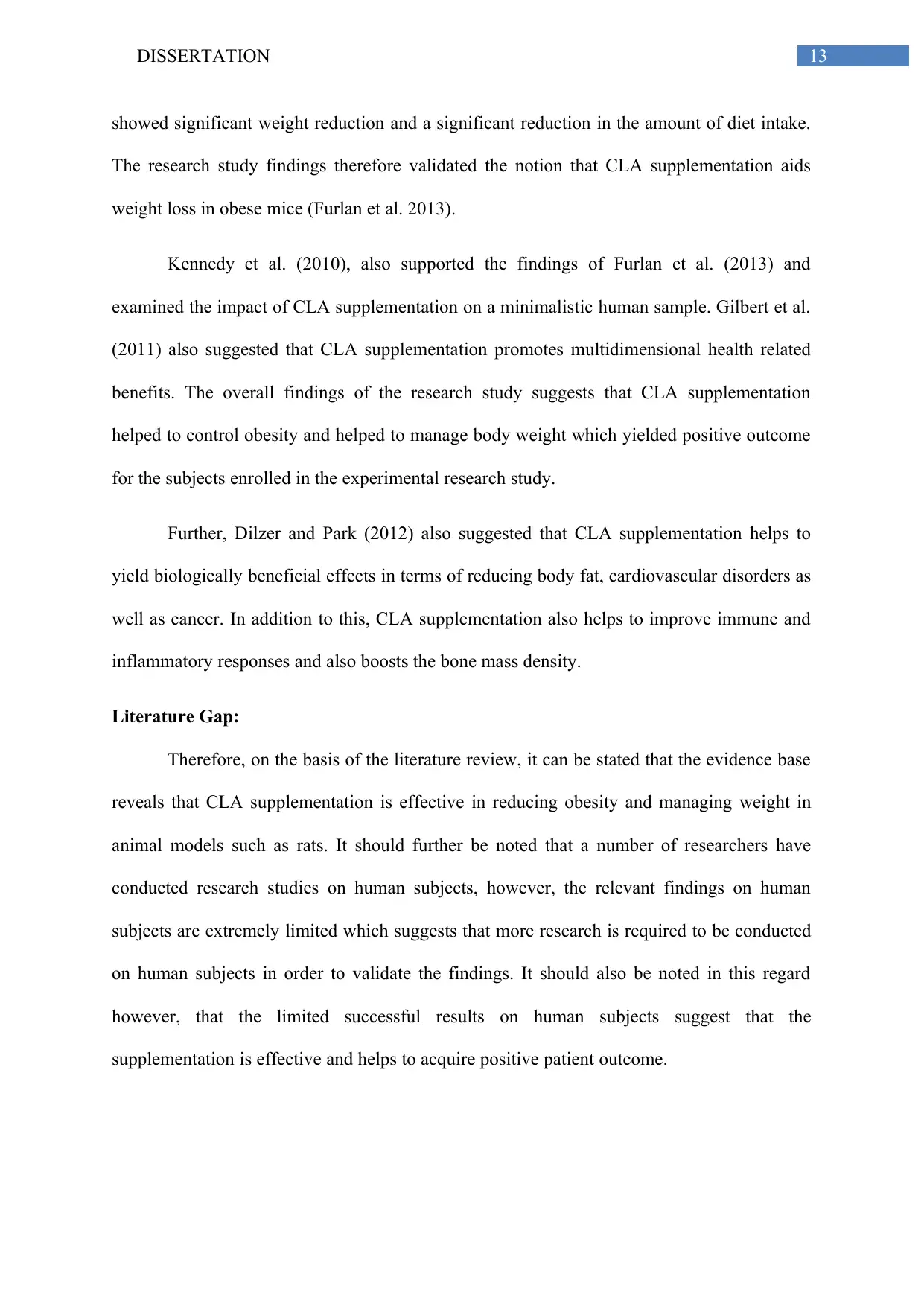
13DISSERTATION
showed significant weight reduction and a significant reduction in the amount of diet intake.
The research study findings therefore validated the notion that CLA supplementation aids
weight loss in obese mice (Furlan et al. 2013).
Kennedy et al. (2010), also supported the findings of Furlan et al. (2013) and
examined the impact of CLA supplementation on a minimalistic human sample. Gilbert et al.
(2011) also suggested that CLA supplementation promotes multidimensional health related
benefits. The overall findings of the research study suggests that CLA supplementation
helped to control obesity and helped to manage body weight which yielded positive outcome
for the subjects enrolled in the experimental research study.
Further, Dilzer and Park (2012) also suggested that CLA supplementation helps to
yield biologically beneficial effects in terms of reducing body fat, cardiovascular disorders as
well as cancer. In addition to this, CLA supplementation also helps to improve immune and
inflammatory responses and also boosts the bone mass density.
Literature Gap:
Therefore, on the basis of the literature review, it can be stated that the evidence base
reveals that CLA supplementation is effective in reducing obesity and managing weight in
animal models such as rats. It should further be noted that a number of researchers have
conducted research studies on human subjects, however, the relevant findings on human
subjects are extremely limited which suggests that more research is required to be conducted
on human subjects in order to validate the findings. It should also be noted in this regard
however, that the limited successful results on human subjects suggest that the
supplementation is effective and helps to acquire positive patient outcome.
showed significant weight reduction and a significant reduction in the amount of diet intake.
The research study findings therefore validated the notion that CLA supplementation aids
weight loss in obese mice (Furlan et al. 2013).
Kennedy et al. (2010), also supported the findings of Furlan et al. (2013) and
examined the impact of CLA supplementation on a minimalistic human sample. Gilbert et al.
(2011) also suggested that CLA supplementation promotes multidimensional health related
benefits. The overall findings of the research study suggests that CLA supplementation
helped to control obesity and helped to manage body weight which yielded positive outcome
for the subjects enrolled in the experimental research study.
Further, Dilzer and Park (2012) also suggested that CLA supplementation helps to
yield biologically beneficial effects in terms of reducing body fat, cardiovascular disorders as
well as cancer. In addition to this, CLA supplementation also helps to improve immune and
inflammatory responses and also boosts the bone mass density.
Literature Gap:
Therefore, on the basis of the literature review, it can be stated that the evidence base
reveals that CLA supplementation is effective in reducing obesity and managing weight in
animal models such as rats. It should further be noted that a number of researchers have
conducted research studies on human subjects, however, the relevant findings on human
subjects are extremely limited which suggests that more research is required to be conducted
on human subjects in order to validate the findings. It should also be noted in this regard
however, that the limited successful results on human subjects suggest that the
supplementation is effective and helps to acquire positive patient outcome.
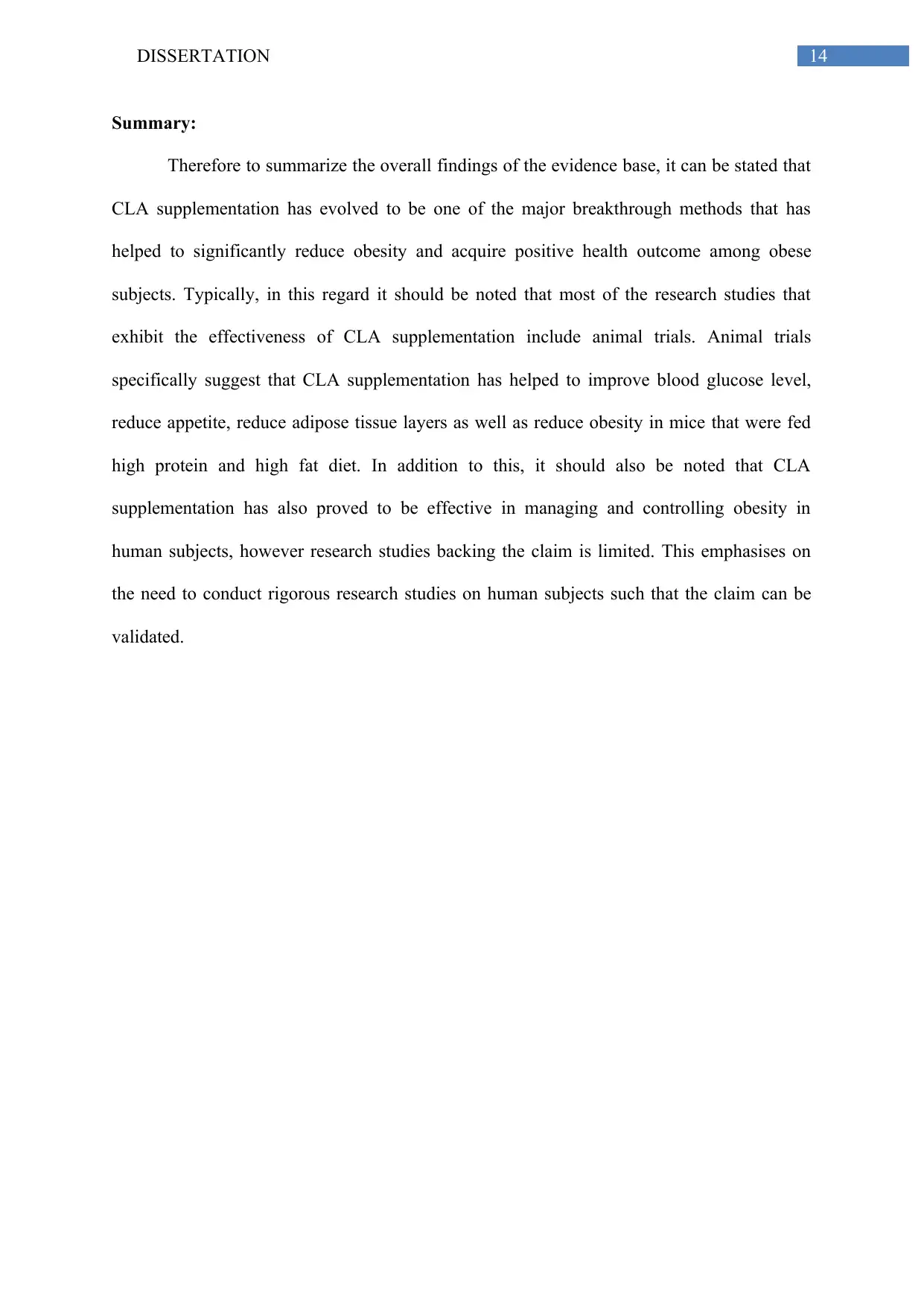
14DISSERTATION
Summary:
Therefore to summarize the overall findings of the evidence base, it can be stated that
CLA supplementation has evolved to be one of the major breakthrough methods that has
helped to significantly reduce obesity and acquire positive health outcome among obese
subjects. Typically, in this regard it should be noted that most of the research studies that
exhibit the effectiveness of CLA supplementation include animal trials. Animal trials
specifically suggest that CLA supplementation has helped to improve blood glucose level,
reduce appetite, reduce adipose tissue layers as well as reduce obesity in mice that were fed
high protein and high fat diet. In addition to this, it should also be noted that CLA
supplementation has also proved to be effective in managing and controlling obesity in
human subjects, however research studies backing the claim is limited. This emphasises on
the need to conduct rigorous research studies on human subjects such that the claim can be
validated.
Summary:
Therefore to summarize the overall findings of the evidence base, it can be stated that
CLA supplementation has evolved to be one of the major breakthrough methods that has
helped to significantly reduce obesity and acquire positive health outcome among obese
subjects. Typically, in this regard it should be noted that most of the research studies that
exhibit the effectiveness of CLA supplementation include animal trials. Animal trials
specifically suggest that CLA supplementation has helped to improve blood glucose level,
reduce appetite, reduce adipose tissue layers as well as reduce obesity in mice that were fed
high protein and high fat diet. In addition to this, it should also be noted that CLA
supplementation has also proved to be effective in managing and controlling obesity in
human subjects, however research studies backing the claim is limited. This emphasises on
the need to conduct rigorous research studies on human subjects such that the claim can be
validated.
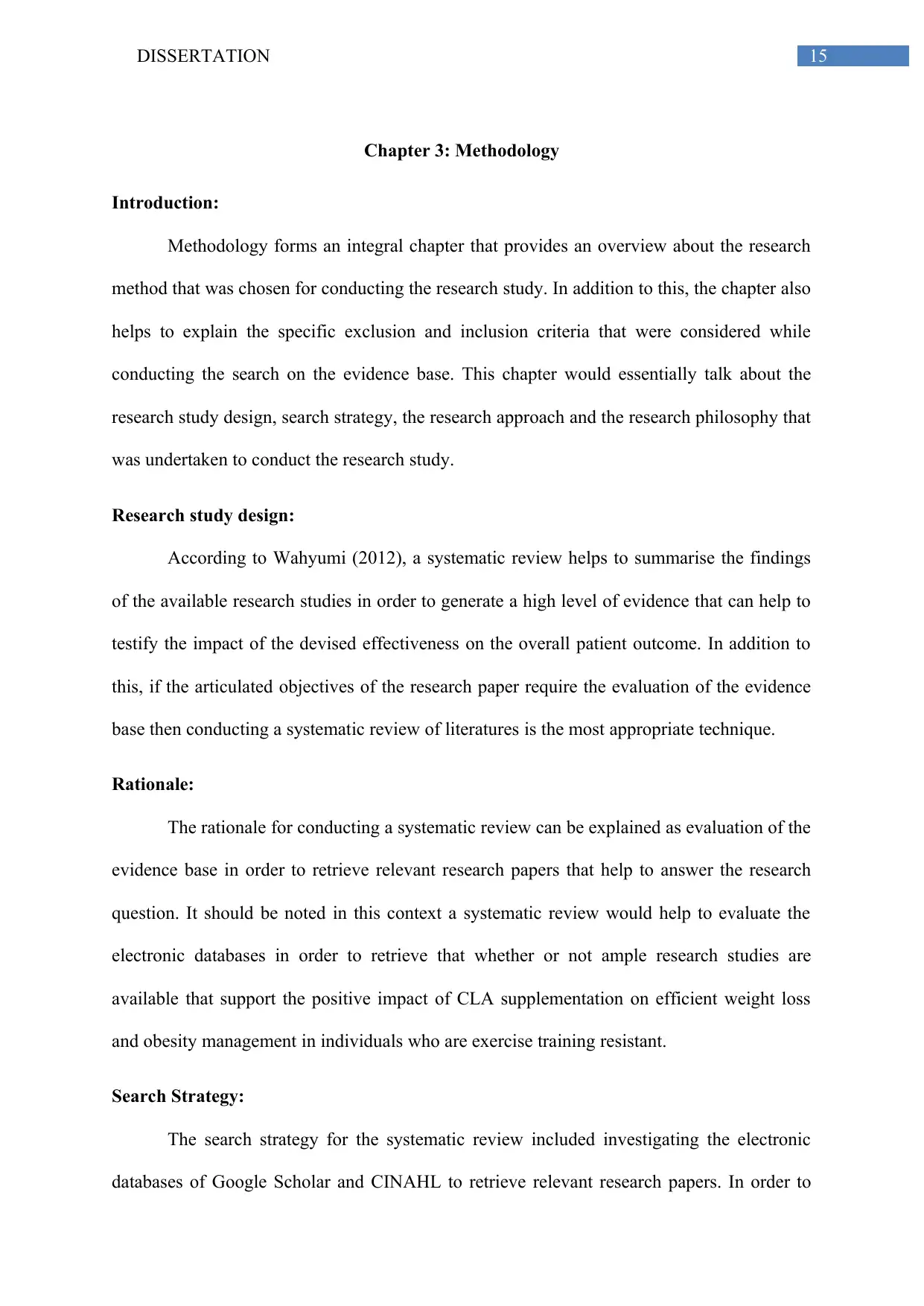
15DISSERTATION
Chapter 3: Methodology
Introduction:
Methodology forms an integral chapter that provides an overview about the research
method that was chosen for conducting the research study. In addition to this, the chapter also
helps to explain the specific exclusion and inclusion criteria that were considered while
conducting the search on the evidence base. This chapter would essentially talk about the
research study design, search strategy, the research approach and the research philosophy that
was undertaken to conduct the research study.
Research study design:
According to Wahyumi (2012), a systematic review helps to summarise the findings
of the available research studies in order to generate a high level of evidence that can help to
testify the impact of the devised effectiveness on the overall patient outcome. In addition to
this, if the articulated objectives of the research paper require the evaluation of the evidence
base then conducting a systematic review of literatures is the most appropriate technique.
Rationale:
The rationale for conducting a systematic review can be explained as evaluation of the
evidence base in order to retrieve relevant research papers that help to answer the research
question. It should be noted in this context a systematic review would help to evaluate the
electronic databases in order to retrieve that whether or not ample research studies are
available that support the positive impact of CLA supplementation on efficient weight loss
and obesity management in individuals who are exercise training resistant.
Search Strategy:
The search strategy for the systematic review included investigating the electronic
databases of Google Scholar and CINAHL to retrieve relevant research papers. In order to
Chapter 3: Methodology
Introduction:
Methodology forms an integral chapter that provides an overview about the research
method that was chosen for conducting the research study. In addition to this, the chapter also
helps to explain the specific exclusion and inclusion criteria that were considered while
conducting the search on the evidence base. This chapter would essentially talk about the
research study design, search strategy, the research approach and the research philosophy that
was undertaken to conduct the research study.
Research study design:
According to Wahyumi (2012), a systematic review helps to summarise the findings
of the available research studies in order to generate a high level of evidence that can help to
testify the impact of the devised effectiveness on the overall patient outcome. In addition to
this, if the articulated objectives of the research paper require the evaluation of the evidence
base then conducting a systematic review of literatures is the most appropriate technique.
Rationale:
The rationale for conducting a systematic review can be explained as evaluation of the
evidence base in order to retrieve relevant research papers that help to answer the research
question. It should be noted in this context a systematic review would help to evaluate the
electronic databases in order to retrieve that whether or not ample research studies are
available that support the positive impact of CLA supplementation on efficient weight loss
and obesity management in individuals who are exercise training resistant.
Search Strategy:
The search strategy for the systematic review included investigating the electronic
databases of Google Scholar and CINAHL to retrieve relevant research papers. In order to
Paraphrase This Document
Need a fresh take? Get an instant paraphrase of this document with our AI Paraphraser
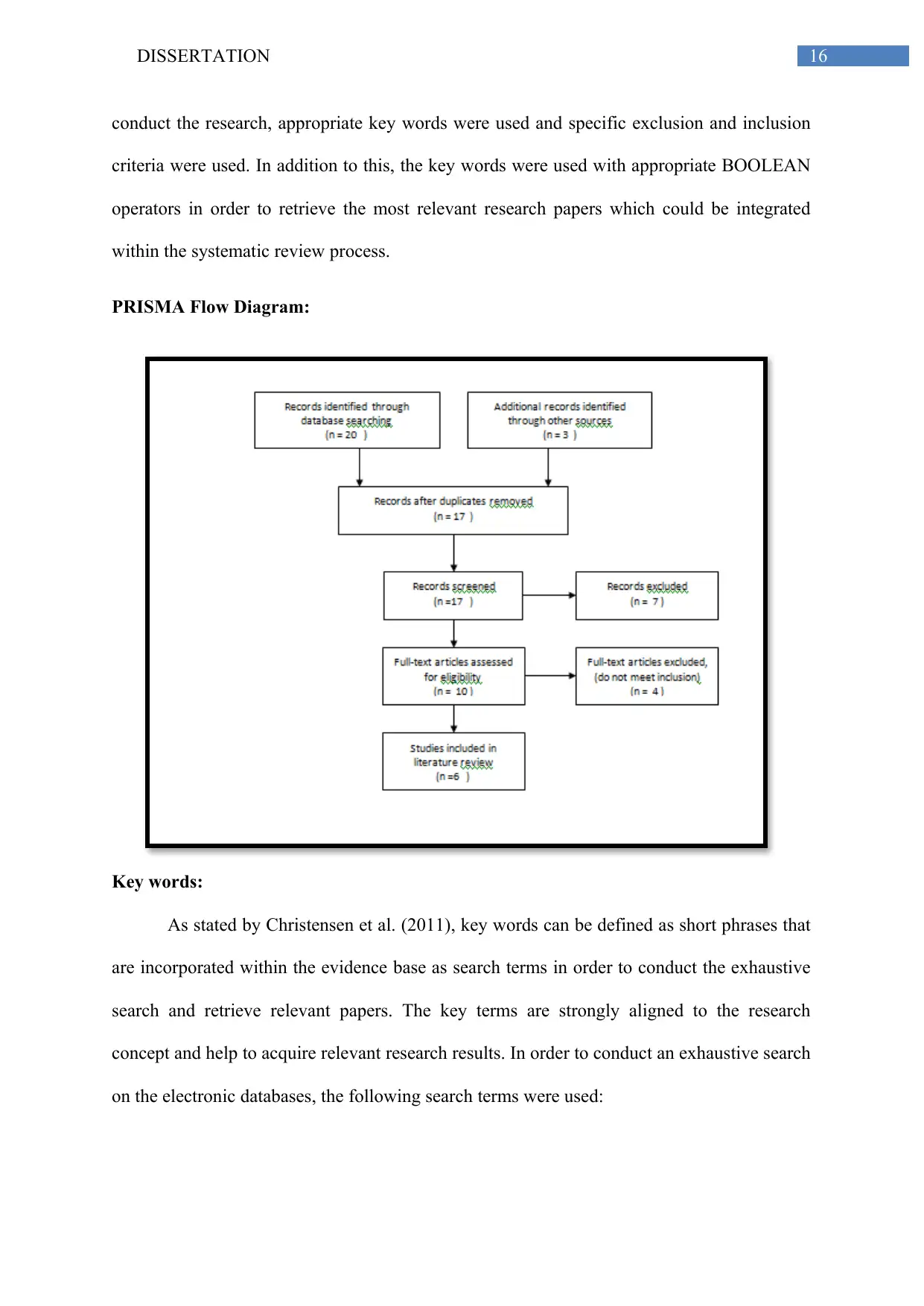
16DISSERTATION
conduct the research, appropriate key words were used and specific exclusion and inclusion
criteria were used. In addition to this, the key words were used with appropriate BOOLEAN
operators in order to retrieve the most relevant research papers which could be integrated
within the systematic review process.
PRISMA Flow Diagram:
Key words:
As stated by Christensen et al. (2011), key words can be defined as short phrases that
are incorporated within the evidence base as search terms in order to conduct the exhaustive
search and retrieve relevant papers. The key terms are strongly aligned to the research
concept and help to acquire relevant research results. In order to conduct an exhaustive search
on the electronic databases, the following search terms were used:
conduct the research, appropriate key words were used and specific exclusion and inclusion
criteria were used. In addition to this, the key words were used with appropriate BOOLEAN
operators in order to retrieve the most relevant research papers which could be integrated
within the systematic review process.
PRISMA Flow Diagram:
Key words:
As stated by Christensen et al. (2011), key words can be defined as short phrases that
are incorporated within the evidence base as search terms in order to conduct the exhaustive
search and retrieve relevant papers. The key terms are strongly aligned to the research
concept and help to acquire relevant research results. In order to conduct an exhaustive search
on the electronic databases, the following search terms were used:
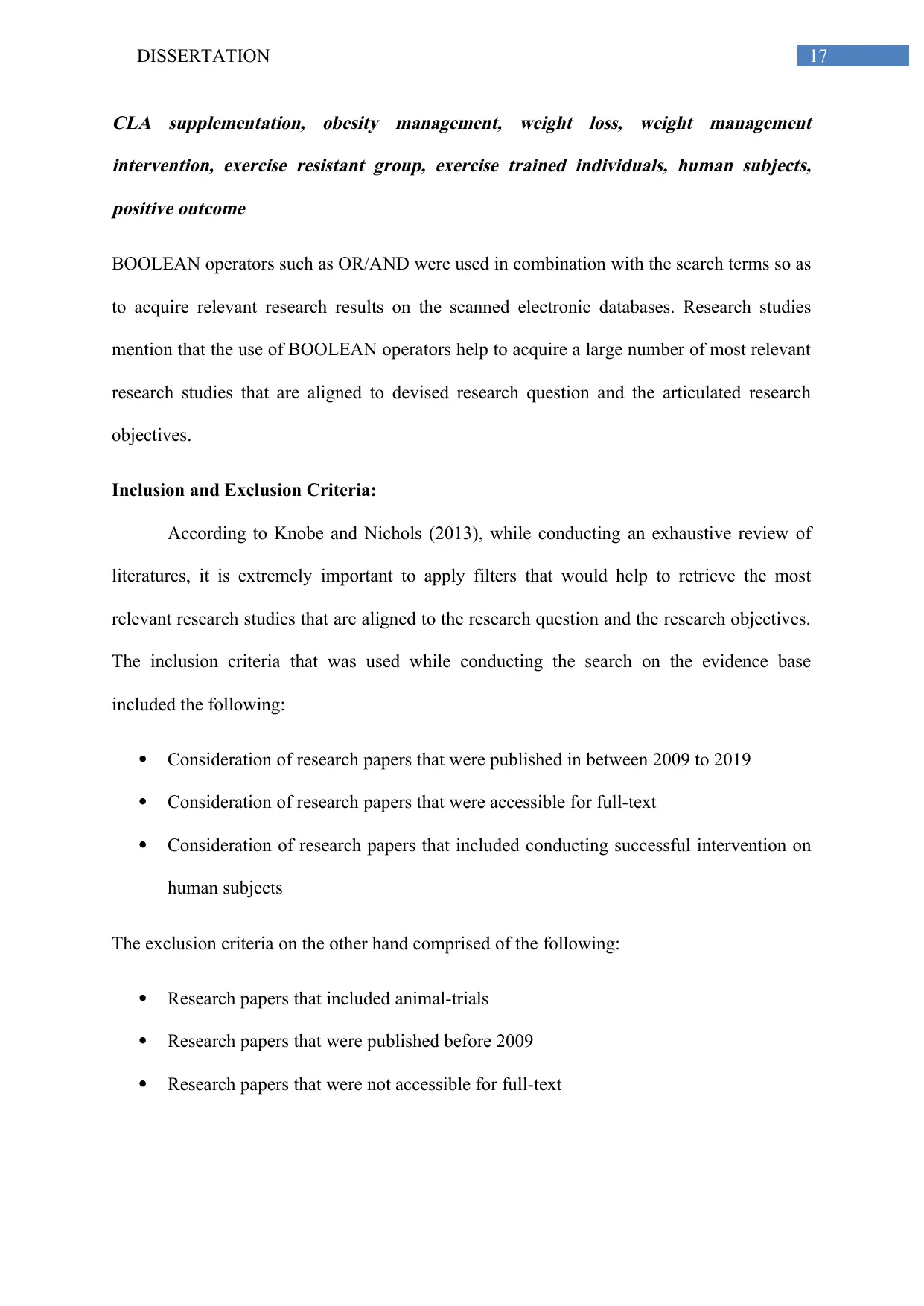
17DISSERTATION
CLA supplementation, obesity management, weight loss, weight management
intervention, exercise resistant group, exercise trained individuals, human subjects,
positive outcome
BOOLEAN operators such as OR/AND were used in combination with the search terms so as
to acquire relevant research results on the scanned electronic databases. Research studies
mention that the use of BOOLEAN operators help to acquire a large number of most relevant
research studies that are aligned to devised research question and the articulated research
objectives.
Inclusion and Exclusion Criteria:
According to Knobe and Nichols (2013), while conducting an exhaustive review of
literatures, it is extremely important to apply filters that would help to retrieve the most
relevant research studies that are aligned to the research question and the research objectives.
The inclusion criteria that was used while conducting the search on the evidence base
included the following:
Consideration of research papers that were published in between 2009 to 2019
Consideration of research papers that were accessible for full-text
Consideration of research papers that included conducting successful intervention on
human subjects
The exclusion criteria on the other hand comprised of the following:
Research papers that included animal-trials
Research papers that were published before 2009
Research papers that were not accessible for full-text
CLA supplementation, obesity management, weight loss, weight management
intervention, exercise resistant group, exercise trained individuals, human subjects,
positive outcome
BOOLEAN operators such as OR/AND were used in combination with the search terms so as
to acquire relevant research results on the scanned electronic databases. Research studies
mention that the use of BOOLEAN operators help to acquire a large number of most relevant
research studies that are aligned to devised research question and the articulated research
objectives.
Inclusion and Exclusion Criteria:
According to Knobe and Nichols (2013), while conducting an exhaustive review of
literatures, it is extremely important to apply filters that would help to retrieve the most
relevant research studies that are aligned to the research question and the research objectives.
The inclusion criteria that was used while conducting the search on the evidence base
included the following:
Consideration of research papers that were published in between 2009 to 2019
Consideration of research papers that were accessible for full-text
Consideration of research papers that included conducting successful intervention on
human subjects
The exclusion criteria on the other hand comprised of the following:
Research papers that included animal-trials
Research papers that were published before 2009
Research papers that were not accessible for full-text

18DISSERTATION
Research Approach:
As per Hughes and Sharrock (2016), research approach can be of two types inductive
or deductive. In cases, where the review of literatures is conducted on the basis of the
assumed hypothesis, the research approach is said to be deductive. In the similar manner, the
inductive approach primarily considers the retrieved research papers from the evidence base
in order to identify and discuss repetitive themes. In this case, the inductive research
approach would be used to thoroughly investigate the evidence base and retrieve relevant
papers that are aligned to the articulated research objectives. Further, the inductive research
approach would also help to identify the repetitive themes in the research papers that have
been considered in the review. This would help to discuss the included research papers within
the review process on the basis of the common emerging themes and validate the proposed
research question that whether or not CLA supplementation can help to manage weight and
prevent obesity among exercise resistant group of individuals.
Research Philosophy:
There are three broad categories of research philosophies that include positivism,
interpretivismand realism (Knobe and Nichols 2013). An interpretivist approach is widely
used in case of qualitative research designs. The basis of the philosophy can be explained as
evaluating the evidence base in order to generate a new theory. In this case, the interpretivism
research philosophy would be adapted to critically evaluate the evidence base and retrieve
relevant research studies that help answer the research question and on the basis of the
retrieved research papers a new theory can be explained and generated.
Conclusion:
Therefore, to conclude it should be mentioned that the research design that would be
chosen to conduct the research study would include conducting a systematic review. Further,
Research Approach:
As per Hughes and Sharrock (2016), research approach can be of two types inductive
or deductive. In cases, where the review of literatures is conducted on the basis of the
assumed hypothesis, the research approach is said to be deductive. In the similar manner, the
inductive approach primarily considers the retrieved research papers from the evidence base
in order to identify and discuss repetitive themes. In this case, the inductive research
approach would be used to thoroughly investigate the evidence base and retrieve relevant
papers that are aligned to the articulated research objectives. Further, the inductive research
approach would also help to identify the repetitive themes in the research papers that have
been considered in the review. This would help to discuss the included research papers within
the review process on the basis of the common emerging themes and validate the proposed
research question that whether or not CLA supplementation can help to manage weight and
prevent obesity among exercise resistant group of individuals.
Research Philosophy:
There are three broad categories of research philosophies that include positivism,
interpretivismand realism (Knobe and Nichols 2013). An interpretivist approach is widely
used in case of qualitative research designs. The basis of the philosophy can be explained as
evaluating the evidence base in order to generate a new theory. In this case, the interpretivism
research philosophy would be adapted to critically evaluate the evidence base and retrieve
relevant research studies that help answer the research question and on the basis of the
retrieved research papers a new theory can be explained and generated.
Conclusion:
Therefore, to conclude it should be mentioned that the research design that would be
chosen to conduct the research study would include conducting a systematic review. Further,
Secure Best Marks with AI Grader
Need help grading? Try our AI Grader for instant feedback on your assignments.

19DISSERTATION
an inductive research approach and interpretive research philosophy would be undertaken to
conduct the systematic review and acquire relevant answers to the devised research questions.
an inductive research approach and interpretive research philosophy would be undertaken to
conduct the systematic review and acquire relevant answers to the devised research questions.
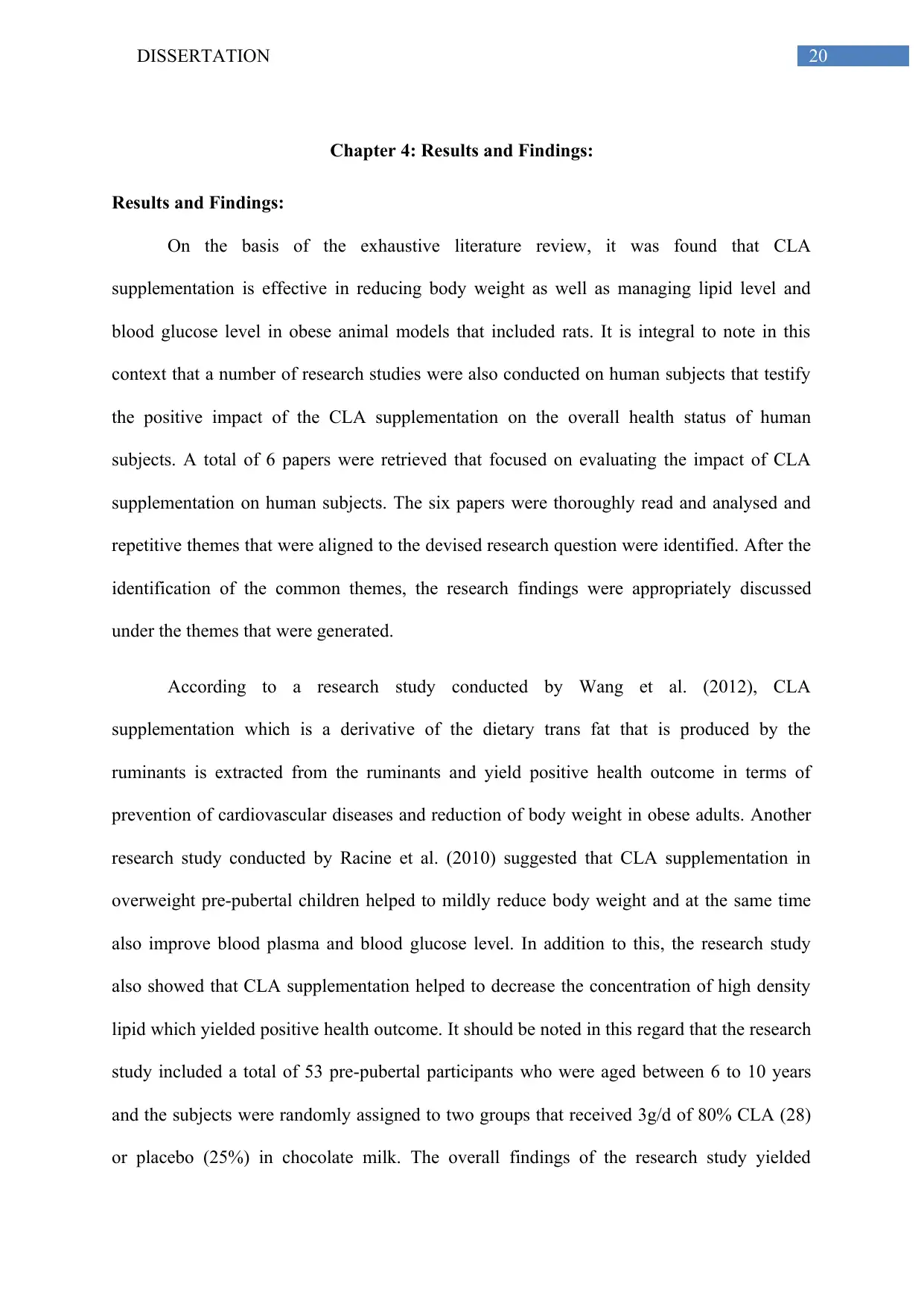
20DISSERTATION
Chapter 4: Results and Findings:
Results and Findings:
On the basis of the exhaustive literature review, it was found that CLA
supplementation is effective in reducing body weight as well as managing lipid level and
blood glucose level in obese animal models that included rats. It is integral to note in this
context that a number of research studies were also conducted on human subjects that testify
the positive impact of the CLA supplementation on the overall health status of human
subjects. A total of 6 papers were retrieved that focused on evaluating the impact of CLA
supplementation on human subjects. The six papers were thoroughly read and analysed and
repetitive themes that were aligned to the devised research question were identified. After the
identification of the common themes, the research findings were appropriately discussed
under the themes that were generated.
According to a research study conducted by Wang et al. (2012), CLA
supplementation which is a derivative of the dietary trans fat that is produced by the
ruminants is extracted from the ruminants and yield positive health outcome in terms of
prevention of cardiovascular diseases and reduction of body weight in obese adults. Another
research study conducted by Racine et al. (2010) suggested that CLA supplementation in
overweight pre-pubertal children helped to mildly reduce body weight and at the same time
also improve blood plasma and blood glucose level. In addition to this, the research study
also showed that CLA supplementation helped to decrease the concentration of high density
lipid which yielded positive health outcome. It should be noted in this regard that the research
study included a total of 53 pre-pubertal participants who were aged between 6 to 10 years
and the subjects were randomly assigned to two groups that received 3g/d of 80% CLA (28)
or placebo (25%) in chocolate milk. The overall findings of the research study yielded
Chapter 4: Results and Findings:
Results and Findings:
On the basis of the exhaustive literature review, it was found that CLA
supplementation is effective in reducing body weight as well as managing lipid level and
blood glucose level in obese animal models that included rats. It is integral to note in this
context that a number of research studies were also conducted on human subjects that testify
the positive impact of the CLA supplementation on the overall health status of human
subjects. A total of 6 papers were retrieved that focused on evaluating the impact of CLA
supplementation on human subjects. The six papers were thoroughly read and analysed and
repetitive themes that were aligned to the devised research question were identified. After the
identification of the common themes, the research findings were appropriately discussed
under the themes that were generated.
According to a research study conducted by Wang et al. (2012), CLA
supplementation which is a derivative of the dietary trans fat that is produced by the
ruminants is extracted from the ruminants and yield positive health outcome in terms of
prevention of cardiovascular diseases and reduction of body weight in obese adults. Another
research study conducted by Racine et al. (2010) suggested that CLA supplementation in
overweight pre-pubertal children helped to mildly reduce body weight and at the same time
also improve blood plasma and blood glucose level. In addition to this, the research study
also showed that CLA supplementation helped to decrease the concentration of high density
lipid which yielded positive health outcome. It should be noted in this regard that the research
study included a total of 53 pre-pubertal participants who were aged between 6 to 10 years
and the subjects were randomly assigned to two groups that received 3g/d of 80% CLA (28)
or placebo (25%) in chocolate milk. The overall findings of the research study yielded
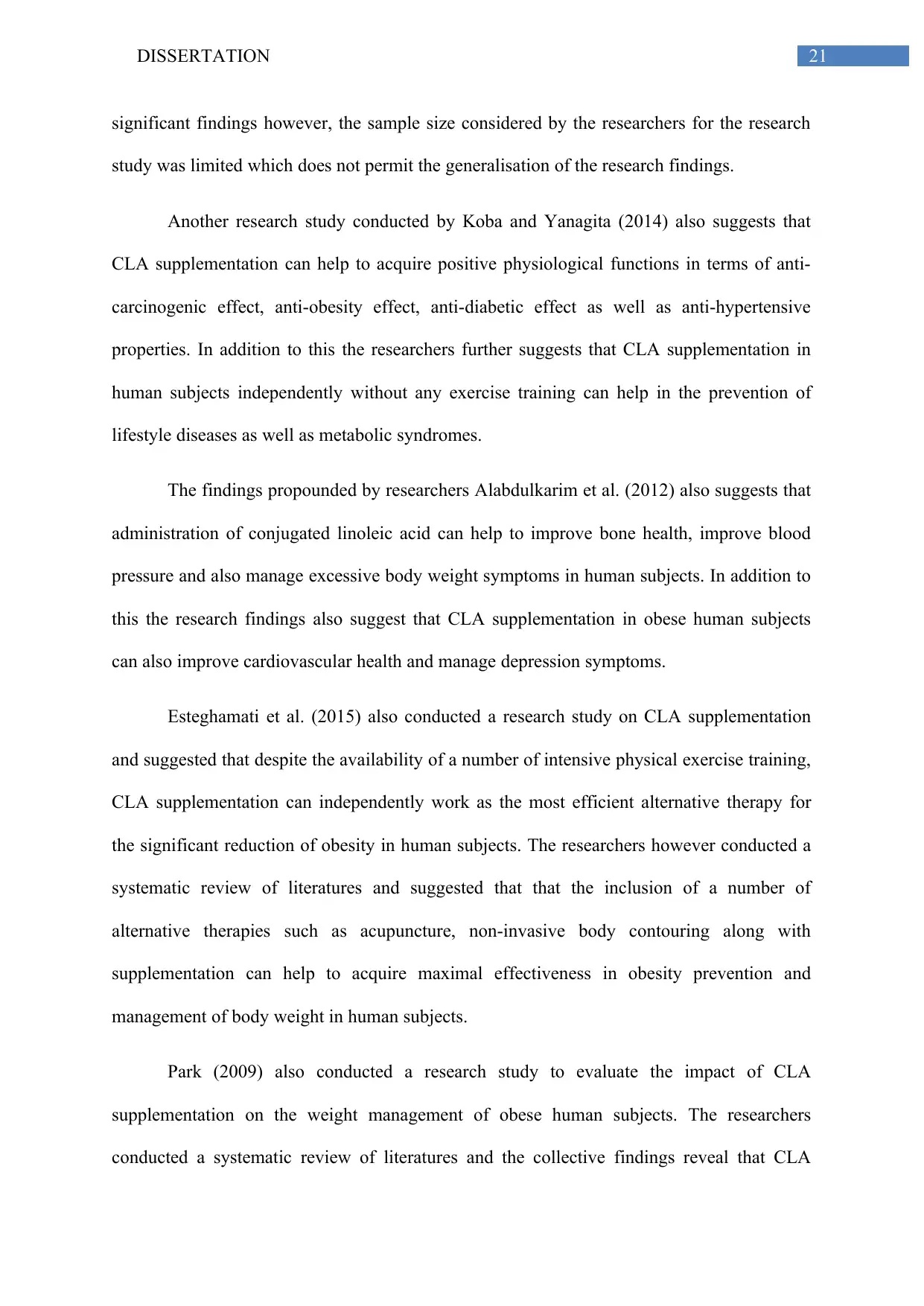
21DISSERTATION
significant findings however, the sample size considered by the researchers for the research
study was limited which does not permit the generalisation of the research findings.
Another research study conducted by Koba and Yanagita (2014) also suggests that
CLA supplementation can help to acquire positive physiological functions in terms of anti-
carcinogenic effect, anti-obesity effect, anti-diabetic effect as well as anti-hypertensive
properties. In addition to this the researchers further suggests that CLA supplementation in
human subjects independently without any exercise training can help in the prevention of
lifestyle diseases as well as metabolic syndromes.
The findings propounded by researchers Alabdulkarim et al. (2012) also suggests that
administration of conjugated linoleic acid can help to improve bone health, improve blood
pressure and also manage excessive body weight symptoms in human subjects. In addition to
this the research findings also suggest that CLA supplementation in obese human subjects
can also improve cardiovascular health and manage depression symptoms.
Esteghamati et al. (2015) also conducted a research study on CLA supplementation
and suggested that despite the availability of a number of intensive physical exercise training,
CLA supplementation can independently work as the most efficient alternative therapy for
the significant reduction of obesity in human subjects. The researchers however conducted a
systematic review of literatures and suggested that that the inclusion of a number of
alternative therapies such as acupuncture, non-invasive body contouring along with
supplementation can help to acquire maximal effectiveness in obesity prevention and
management of body weight in human subjects.
Park (2009) also conducted a research study to evaluate the impact of CLA
supplementation on the weight management of obese human subjects. The researchers
conducted a systematic review of literatures and the collective findings reveal that CLA
significant findings however, the sample size considered by the researchers for the research
study was limited which does not permit the generalisation of the research findings.
Another research study conducted by Koba and Yanagita (2014) also suggests that
CLA supplementation can help to acquire positive physiological functions in terms of anti-
carcinogenic effect, anti-obesity effect, anti-diabetic effect as well as anti-hypertensive
properties. In addition to this the researchers further suggests that CLA supplementation in
human subjects independently without any exercise training can help in the prevention of
lifestyle diseases as well as metabolic syndromes.
The findings propounded by researchers Alabdulkarim et al. (2012) also suggests that
administration of conjugated linoleic acid can help to improve bone health, improve blood
pressure and also manage excessive body weight symptoms in human subjects. In addition to
this the research findings also suggest that CLA supplementation in obese human subjects
can also improve cardiovascular health and manage depression symptoms.
Esteghamati et al. (2015) also conducted a research study on CLA supplementation
and suggested that despite the availability of a number of intensive physical exercise training,
CLA supplementation can independently work as the most efficient alternative therapy for
the significant reduction of obesity in human subjects. The researchers however conducted a
systematic review of literatures and suggested that that the inclusion of a number of
alternative therapies such as acupuncture, non-invasive body contouring along with
supplementation can help to acquire maximal effectiveness in obesity prevention and
management of body weight in human subjects.
Park (2009) also conducted a research study to evaluate the impact of CLA
supplementation on the weight management of obese human subjects. The researchers
conducted a systematic review of literatures and the collective findings reveal that CLA
Paraphrase This Document
Need a fresh take? Get an instant paraphrase of this document with our AI Paraphraser
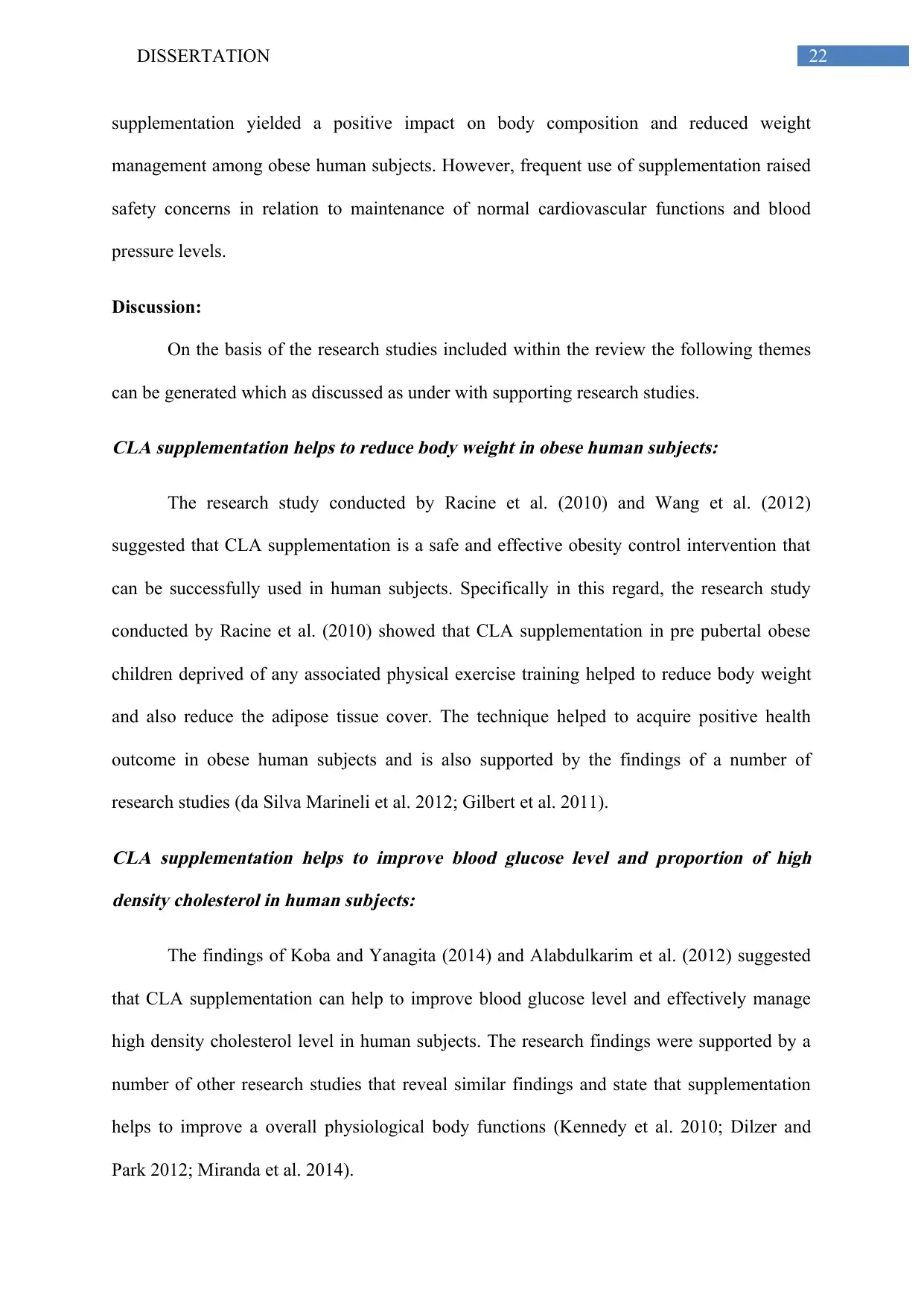
22DISSERTATION
supplementation yielded a positive impact on body composition and reduced weight
management among obese human subjects. However, frequent use of supplementation raised
safety concerns in relation to maintenance of normal cardiovascular functions and blood
pressure levels.
Discussion:
On the basis of the research studies included within the review the following themes
can be generated which as discussed as under with supporting research studies.
CLA supplementation helps to reduce body weight in obese human subjects:
The research study conducted by Racine et al. (2010) and Wang et al. (2012)
suggested that CLA supplementation is a safe and effective obesity control intervention that
can be successfully used in human subjects. Specifically in this regard, the research study
conducted by Racine et al. (2010) showed that CLA supplementation in pre pubertal obese
children deprived of any associated physical exercise training helped to reduce body weight
and also reduce the adipose tissue cover. The technique helped to acquire positive health
outcome in obese human subjects and is also supported by the findings of a number of
research studies (da Silva Marineli et al. 2012; Gilbert et al. 2011).
CLA supplementation helps to improve blood glucose level and proportion of high
density cholesterol in human subjects:
The findings of Koba and Yanagita (2014) and Alabdulkarim et al. (2012) suggested
that CLA supplementation can help to improve blood glucose level and effectively manage
high density cholesterol level in human subjects. The research findings were supported by a
number of other research studies that reveal similar findings and state that supplementation
helps to improve a overall physiological body functions (Kennedy et al. 2010; Dilzer and
Park 2012; Miranda et al. 2014).
supplementation yielded a positive impact on body composition and reduced weight
management among obese human subjects. However, frequent use of supplementation raised
safety concerns in relation to maintenance of normal cardiovascular functions and blood
pressure levels.
Discussion:
On the basis of the research studies included within the review the following themes
can be generated which as discussed as under with supporting research studies.
CLA supplementation helps to reduce body weight in obese human subjects:
The research study conducted by Racine et al. (2010) and Wang et al. (2012)
suggested that CLA supplementation is a safe and effective obesity control intervention that
can be successfully used in human subjects. Specifically in this regard, the research study
conducted by Racine et al. (2010) showed that CLA supplementation in pre pubertal obese
children deprived of any associated physical exercise training helped to reduce body weight
and also reduce the adipose tissue cover. The technique helped to acquire positive health
outcome in obese human subjects and is also supported by the findings of a number of
research studies (da Silva Marineli et al. 2012; Gilbert et al. 2011).
CLA supplementation helps to improve blood glucose level and proportion of high
density cholesterol in human subjects:
The findings of Koba and Yanagita (2014) and Alabdulkarim et al. (2012) suggested
that CLA supplementation can help to improve blood glucose level and effectively manage
high density cholesterol level in human subjects. The research findings were supported by a
number of other research studies that reveal similar findings and state that supplementation
helps to improve a overall physiological body functions (Kennedy et al. 2010; Dilzer and
Park 2012; Miranda et al. 2014).
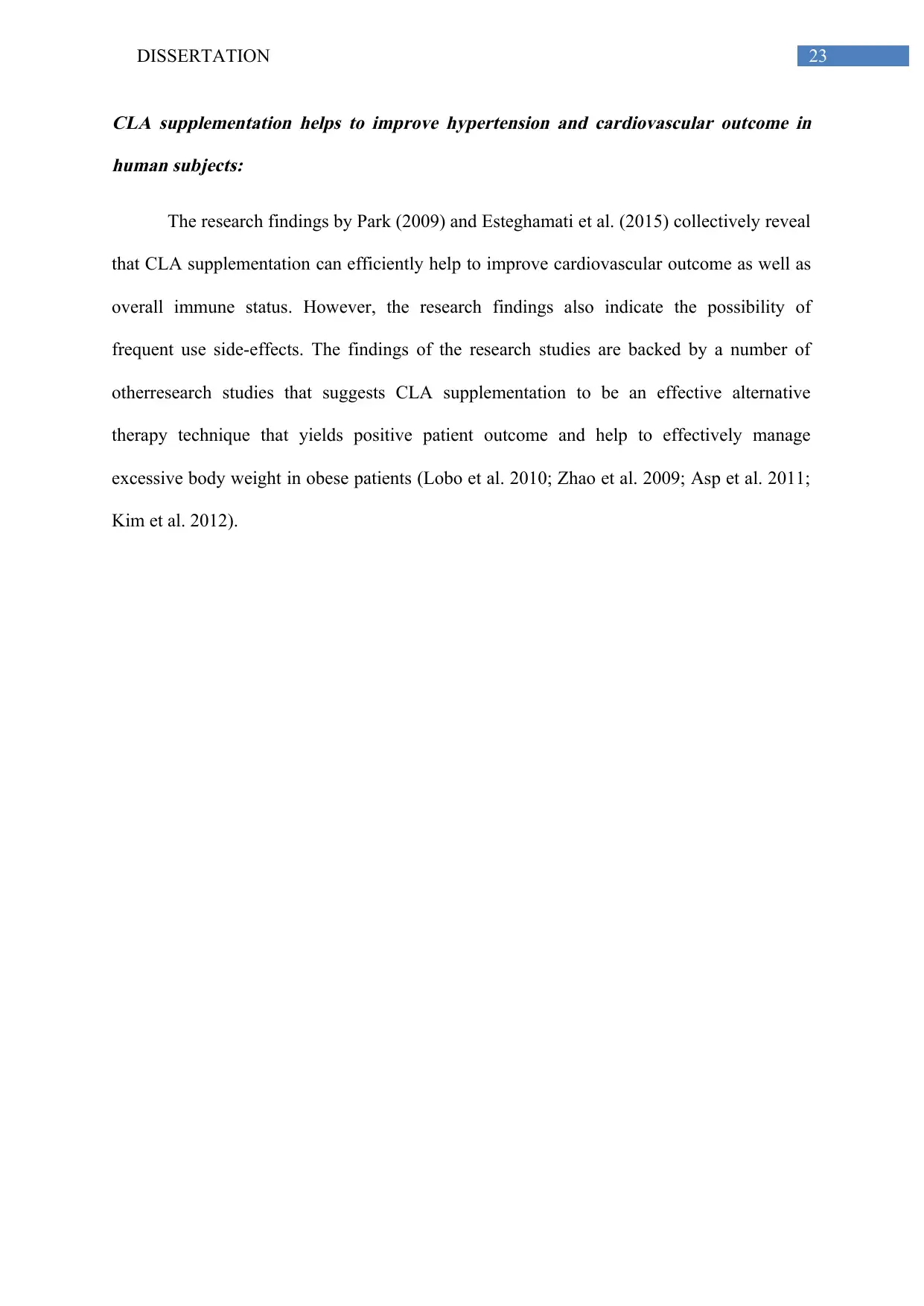
23DISSERTATION
CLA supplementation helps to improve hypertension and cardiovascular outcome in
human subjects:
The research findings by Park (2009) and Esteghamati et al. (2015) collectively reveal
that CLA supplementation can efficiently help to improve cardiovascular outcome as well as
overall immune status. However, the research findings also indicate the possibility of
frequent use side-effects. The findings of the research studies are backed by a number of
otherresearch studies that suggests CLA supplementation to be an effective alternative
therapy technique that yields positive patient outcome and help to effectively manage
excessive body weight in obese patients (Lobo et al. 2010; Zhao et al. 2009; Asp et al. 2011;
Kim et al. 2012).
CLA supplementation helps to improve hypertension and cardiovascular outcome in
human subjects:
The research findings by Park (2009) and Esteghamati et al. (2015) collectively reveal
that CLA supplementation can efficiently help to improve cardiovascular outcome as well as
overall immune status. However, the research findings also indicate the possibility of
frequent use side-effects. The findings of the research studies are backed by a number of
otherresearch studies that suggests CLA supplementation to be an effective alternative
therapy technique that yields positive patient outcome and help to effectively manage
excessive body weight in obese patients (Lobo et al. 2010; Zhao et al. 2009; Asp et al. 2011;
Kim et al. 2012).
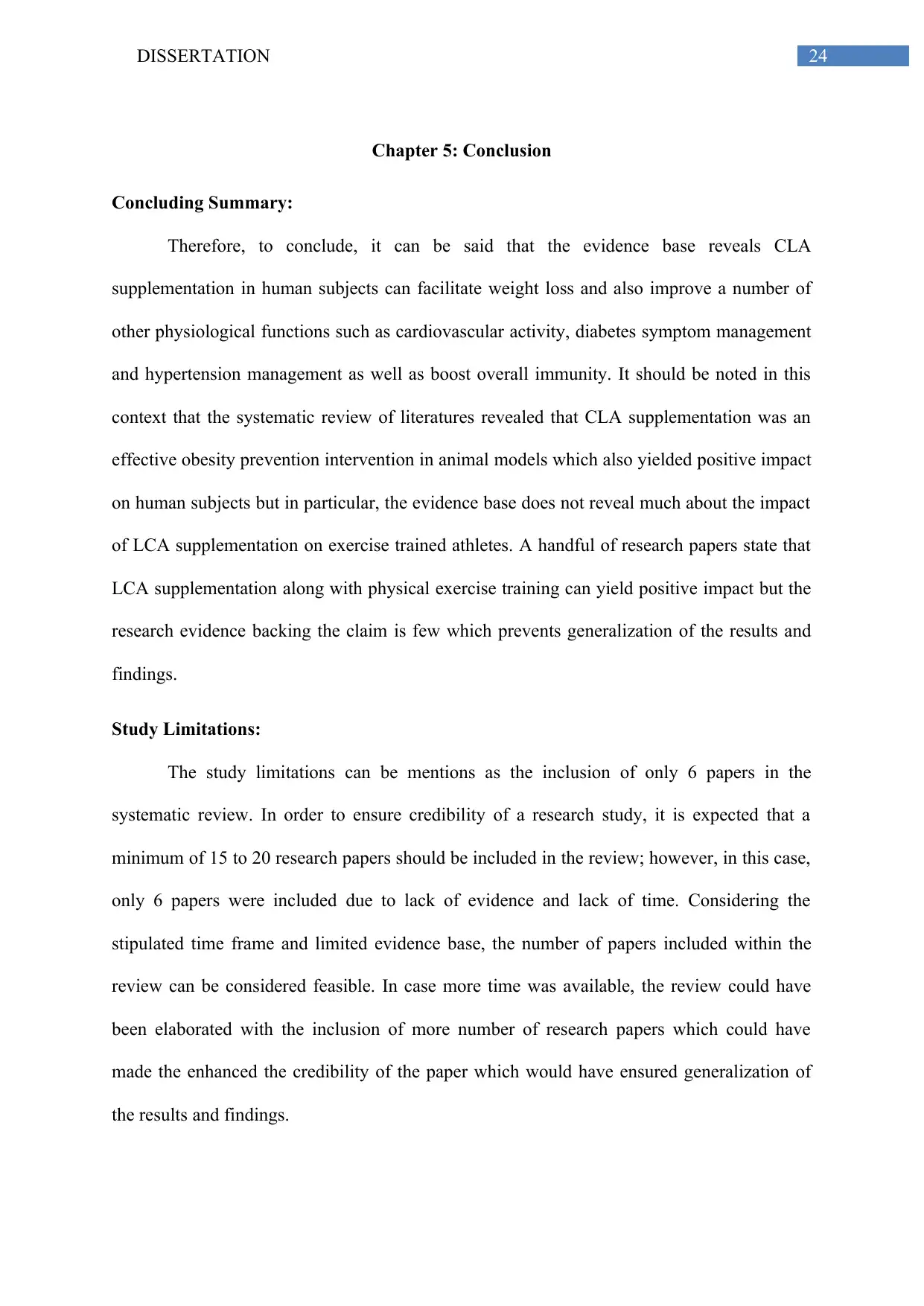
24DISSERTATION
Chapter 5: Conclusion
Concluding Summary:
Therefore, to conclude, it can be said that the evidence base reveals CLA
supplementation in human subjects can facilitate weight loss and also improve a number of
other physiological functions such as cardiovascular activity, diabetes symptom management
and hypertension management as well as boost overall immunity. It should be noted in this
context that the systematic review of literatures revealed that CLA supplementation was an
effective obesity prevention intervention in animal models which also yielded positive impact
on human subjects but in particular, the evidence base does not reveal much about the impact
of LCA supplementation on exercise trained athletes. A handful of research papers state that
LCA supplementation along with physical exercise training can yield positive impact but the
research evidence backing the claim is few which prevents generalization of the results and
findings.
Study Limitations:
The study limitations can be mentions as the inclusion of only 6 papers in the
systematic review. In order to ensure credibility of a research study, it is expected that a
minimum of 15 to 20 research papers should be included in the review; however, in this case,
only 6 papers were included due to lack of evidence and lack of time. Considering the
stipulated time frame and limited evidence base, the number of papers included within the
review can be considered feasible. In case more time was available, the review could have
been elaborated with the inclusion of more number of research papers which could have
made the enhanced the credibility of the paper which would have ensured generalization of
the results and findings.
Chapter 5: Conclusion
Concluding Summary:
Therefore, to conclude, it can be said that the evidence base reveals CLA
supplementation in human subjects can facilitate weight loss and also improve a number of
other physiological functions such as cardiovascular activity, diabetes symptom management
and hypertension management as well as boost overall immunity. It should be noted in this
context that the systematic review of literatures revealed that CLA supplementation was an
effective obesity prevention intervention in animal models which also yielded positive impact
on human subjects but in particular, the evidence base does not reveal much about the impact
of LCA supplementation on exercise trained athletes. A handful of research papers state that
LCA supplementation along with physical exercise training can yield positive impact but the
research evidence backing the claim is few which prevents generalization of the results and
findings.
Study Limitations:
The study limitations can be mentions as the inclusion of only 6 papers in the
systematic review. In order to ensure credibility of a research study, it is expected that a
minimum of 15 to 20 research papers should be included in the review; however, in this case,
only 6 papers were included due to lack of evidence and lack of time. Considering the
stipulated time frame and limited evidence base, the number of papers included within the
review can be considered feasible. In case more time was available, the review could have
been elaborated with the inclusion of more number of research papers which could have
made the enhanced the credibility of the paper which would have ensured generalization of
the results and findings.
Secure Best Marks with AI Grader
Need help grading? Try our AI Grader for instant feedback on your assignments.
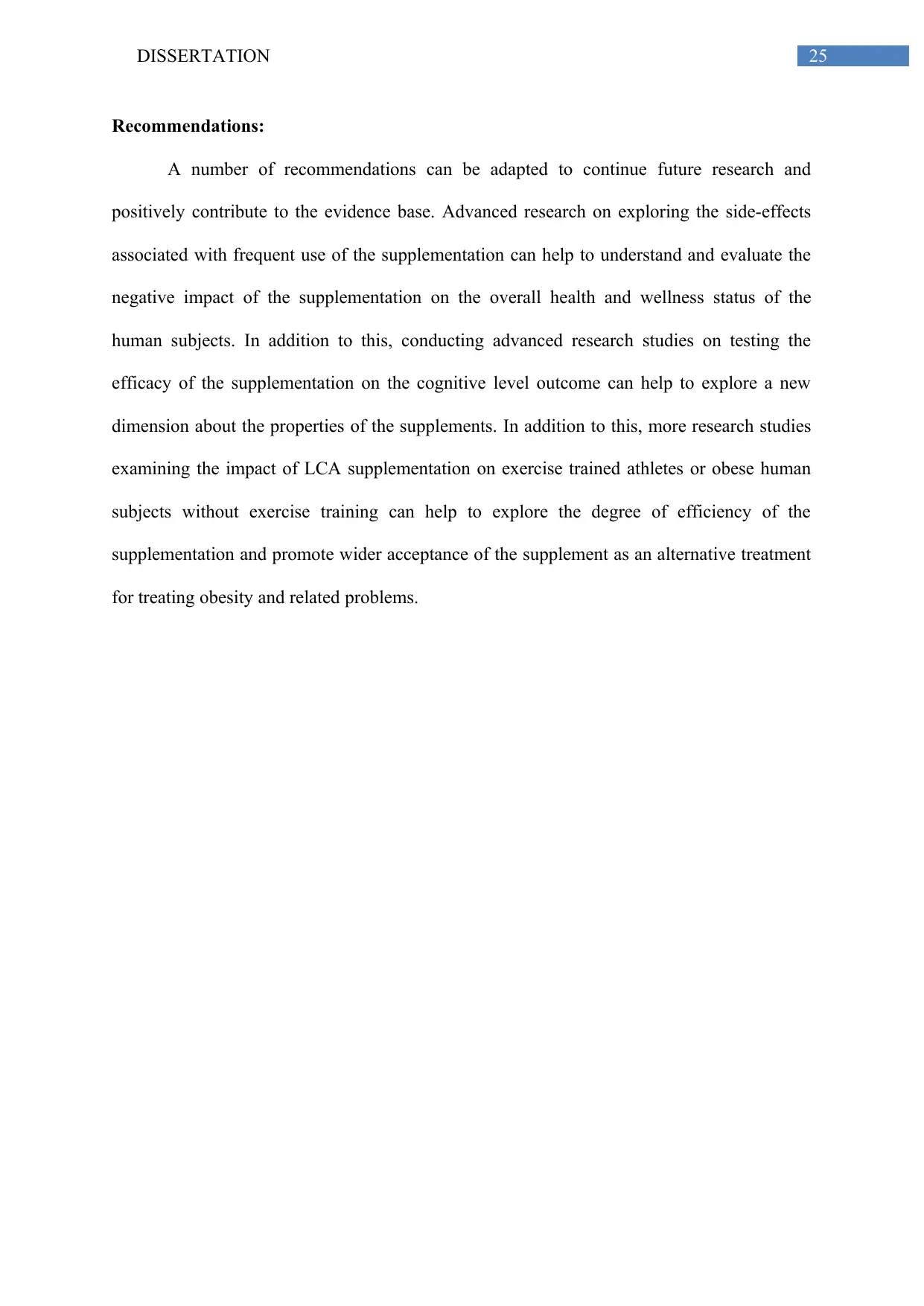
25DISSERTATION
Recommendations:
A number of recommendations can be adapted to continue future research and
positively contribute to the evidence base. Advanced research on exploring the side-effects
associated with frequent use of the supplementation can help to understand and evaluate the
negative impact of the supplementation on the overall health and wellness status of the
human subjects. In addition to this, conducting advanced research studies on testing the
efficacy of the supplementation on the cognitive level outcome can help to explore a new
dimension about the properties of the supplements. In addition to this, more research studies
examining the impact of LCA supplementation on exercise trained athletes or obese human
subjects without exercise training can help to explore the degree of efficiency of the
supplementation and promote wider acceptance of the supplement as an alternative treatment
for treating obesity and related problems.
Recommendations:
A number of recommendations can be adapted to continue future research and
positively contribute to the evidence base. Advanced research on exploring the side-effects
associated with frequent use of the supplementation can help to understand and evaluate the
negative impact of the supplementation on the overall health and wellness status of the
human subjects. In addition to this, conducting advanced research studies on testing the
efficacy of the supplementation on the cognitive level outcome can help to explore a new
dimension about the properties of the supplements. In addition to this, more research studies
examining the impact of LCA supplementation on exercise trained athletes or obese human
subjects without exercise training can help to explore the degree of efficiency of the
supplementation and promote wider acceptance of the supplement as an alternative treatment
for treating obesity and related problems.
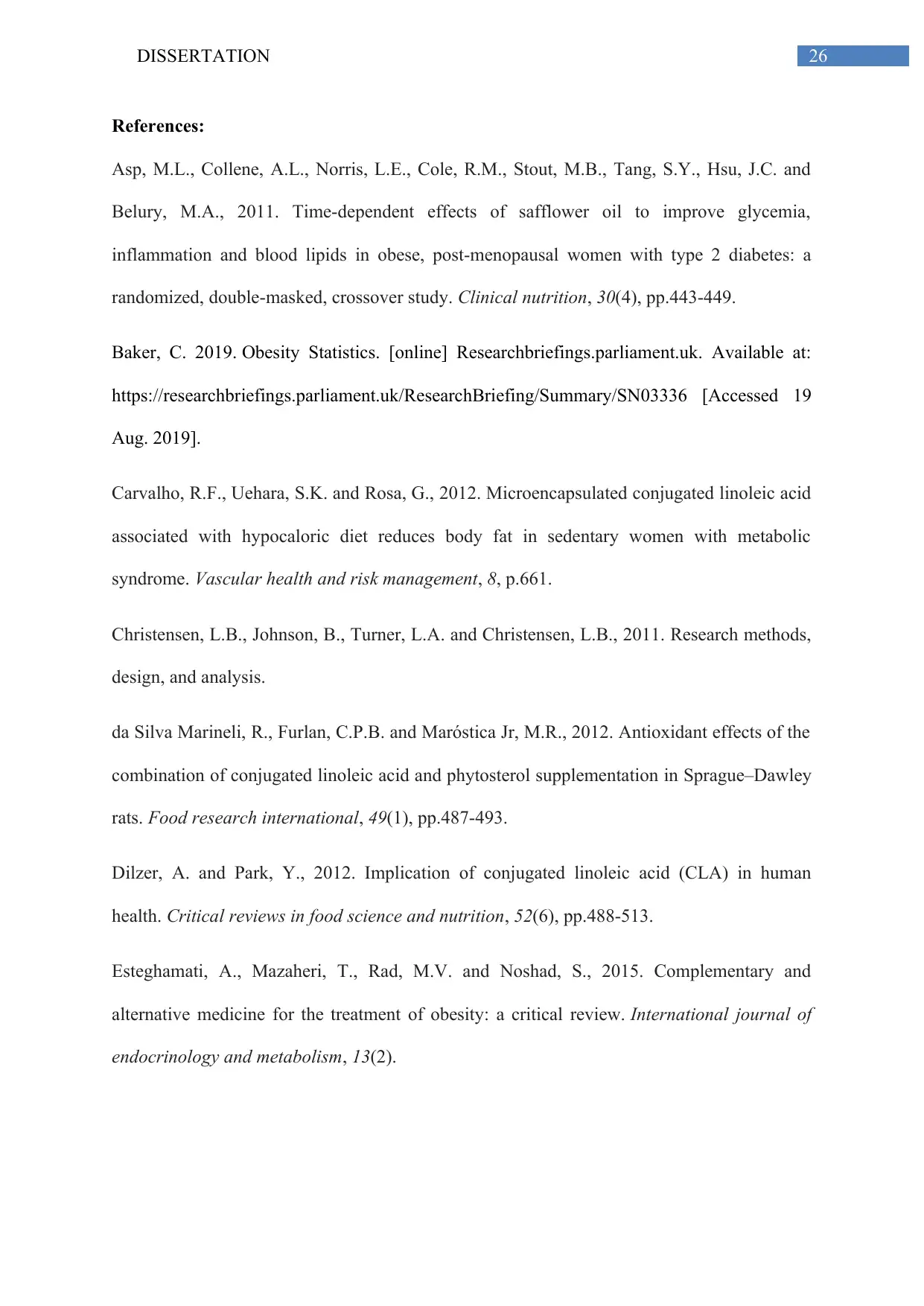
26DISSERTATION
References:
Asp, M.L., Collene, A.L., Norris, L.E., Cole, R.M., Stout, M.B., Tang, S.Y., Hsu, J.C. and
Belury, M.A., 2011. Time-dependent effects of safflower oil to improve glycemia,
inflammation and blood lipids in obese, post-menopausal women with type 2 diabetes: a
randomized, double-masked, crossover study. Clinical nutrition, 30(4), pp.443-449.
Baker, C. 2019. Obesity Statistics. [online] Researchbriefings.parliament.uk. Available at:
https://researchbriefings.parliament.uk/ResearchBriefing/Summary/SN03336 [Accessed 19
Aug. 2019].
Carvalho, R.F., Uehara, S.K. and Rosa, G., 2012. Microencapsulated conjugated linoleic acid
associated with hypocaloric diet reduces body fat in sedentary women with metabolic
syndrome. Vascular health and risk management, 8, p.661.
Christensen, L.B., Johnson, B., Turner, L.A. and Christensen, L.B., 2011. Research methods,
design, and analysis.
da Silva Marineli, R., Furlan, C.P.B. and Maróstica Jr, M.R., 2012. Antioxidant effects of the
combination of conjugated linoleic acid and phytosterol supplementation in Sprague–Dawley
rats. Food research international, 49(1), pp.487-493.
Dilzer, A. and Park, Y., 2012. Implication of conjugated linoleic acid (CLA) in human
health. Critical reviews in food science and nutrition, 52(6), pp.488-513.
Esteghamati, A., Mazaheri, T., Rad, M.V. and Noshad, S., 2015. Complementary and
alternative medicine for the treatment of obesity: a critical review. International journal of
endocrinology and metabolism, 13(2).
References:
Asp, M.L., Collene, A.L., Norris, L.E., Cole, R.M., Stout, M.B., Tang, S.Y., Hsu, J.C. and
Belury, M.A., 2011. Time-dependent effects of safflower oil to improve glycemia,
inflammation and blood lipids in obese, post-menopausal women with type 2 diabetes: a
randomized, double-masked, crossover study. Clinical nutrition, 30(4), pp.443-449.
Baker, C. 2019. Obesity Statistics. [online] Researchbriefings.parliament.uk. Available at:
https://researchbriefings.parliament.uk/ResearchBriefing/Summary/SN03336 [Accessed 19
Aug. 2019].
Carvalho, R.F., Uehara, S.K. and Rosa, G., 2012. Microencapsulated conjugated linoleic acid
associated with hypocaloric diet reduces body fat in sedentary women with metabolic
syndrome. Vascular health and risk management, 8, p.661.
Christensen, L.B., Johnson, B., Turner, L.A. and Christensen, L.B., 2011. Research methods,
design, and analysis.
da Silva Marineli, R., Furlan, C.P.B. and Maróstica Jr, M.R., 2012. Antioxidant effects of the
combination of conjugated linoleic acid and phytosterol supplementation in Sprague–Dawley
rats. Food research international, 49(1), pp.487-493.
Dilzer, A. and Park, Y., 2012. Implication of conjugated linoleic acid (CLA) in human
health. Critical reviews in food science and nutrition, 52(6), pp.488-513.
Esteghamati, A., Mazaheri, T., Rad, M.V. and Noshad, S., 2015. Complementary and
alternative medicine for the treatment of obesity: a critical review. International journal of
endocrinology and metabolism, 13(2).
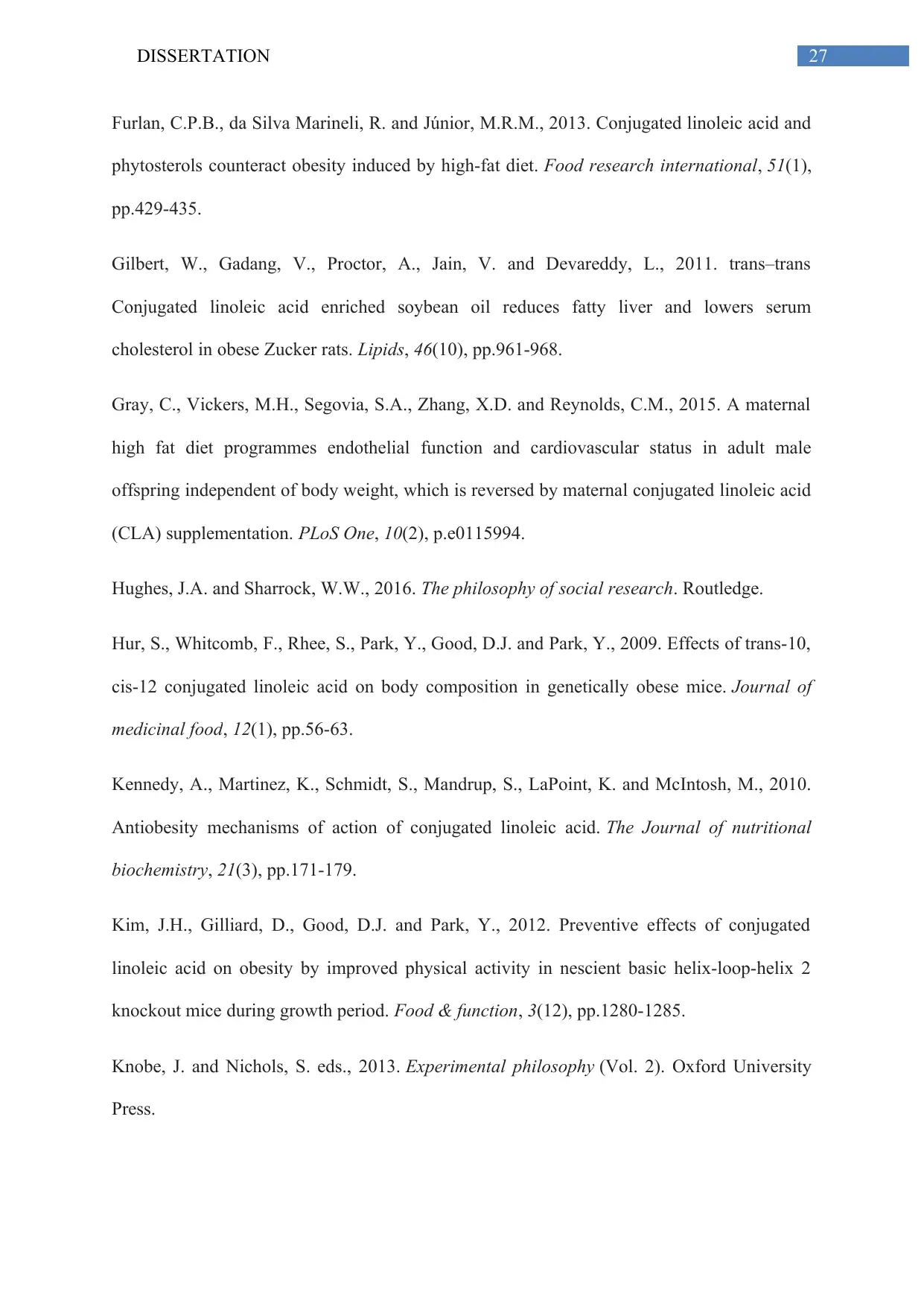
27DISSERTATION
Furlan, C.P.B., da Silva Marineli, R. and Júnior, M.R.M., 2013. Conjugated linoleic acid and
phytosterols counteract obesity induced by high-fat diet. Food research international, 51(1),
pp.429-435.
Gilbert, W., Gadang, V., Proctor, A., Jain, V. and Devareddy, L., 2011. trans–trans
Conjugated linoleic acid enriched soybean oil reduces fatty liver and lowers serum
cholesterol in obese Zucker rats. Lipids, 46(10), pp.961-968.
Gray, C., Vickers, M.H., Segovia, S.A., Zhang, X.D. and Reynolds, C.M., 2015. A maternal
high fat diet programmes endothelial function and cardiovascular status in adult male
offspring independent of body weight, which is reversed by maternal conjugated linoleic acid
(CLA) supplementation. PLoS One, 10(2), p.e0115994.
Hughes, J.A. and Sharrock, W.W., 2016. The philosophy of social research. Routledge.
Hur, S., Whitcomb, F., Rhee, S., Park, Y., Good, D.J. and Park, Y., 2009. Effects of trans-10,
cis-12 conjugated linoleic acid on body composition in genetically obese mice. Journal of
medicinal food, 12(1), pp.56-63.
Kennedy, A., Martinez, K., Schmidt, S., Mandrup, S., LaPoint, K. and McIntosh, M., 2010.
Antiobesity mechanisms of action of conjugated linoleic acid. The Journal of nutritional
biochemistry, 21(3), pp.171-179.
Kim, J.H., Gilliard, D., Good, D.J. and Park, Y., 2012. Preventive effects of conjugated
linoleic acid on obesity by improved physical activity in nescient basic helix-loop-helix 2
knockout mice during growth period. Food & function, 3(12), pp.1280-1285.
Knobe, J. and Nichols, S. eds., 2013. Experimental philosophy (Vol. 2). Oxford University
Press.
Furlan, C.P.B., da Silva Marineli, R. and Júnior, M.R.M., 2013. Conjugated linoleic acid and
phytosterols counteract obesity induced by high-fat diet. Food research international, 51(1),
pp.429-435.
Gilbert, W., Gadang, V., Proctor, A., Jain, V. and Devareddy, L., 2011. trans–trans
Conjugated linoleic acid enriched soybean oil reduces fatty liver and lowers serum
cholesterol in obese Zucker rats. Lipids, 46(10), pp.961-968.
Gray, C., Vickers, M.H., Segovia, S.A., Zhang, X.D. and Reynolds, C.M., 2015. A maternal
high fat diet programmes endothelial function and cardiovascular status in adult male
offspring independent of body weight, which is reversed by maternal conjugated linoleic acid
(CLA) supplementation. PLoS One, 10(2), p.e0115994.
Hughes, J.A. and Sharrock, W.W., 2016. The philosophy of social research. Routledge.
Hur, S., Whitcomb, F., Rhee, S., Park, Y., Good, D.J. and Park, Y., 2009. Effects of trans-10,
cis-12 conjugated linoleic acid on body composition in genetically obese mice. Journal of
medicinal food, 12(1), pp.56-63.
Kennedy, A., Martinez, K., Schmidt, S., Mandrup, S., LaPoint, K. and McIntosh, M., 2010.
Antiobesity mechanisms of action of conjugated linoleic acid. The Journal of nutritional
biochemistry, 21(3), pp.171-179.
Kim, J.H., Gilliard, D., Good, D.J. and Park, Y., 2012. Preventive effects of conjugated
linoleic acid on obesity by improved physical activity in nescient basic helix-loop-helix 2
knockout mice during growth period. Food & function, 3(12), pp.1280-1285.
Knobe, J. and Nichols, S. eds., 2013. Experimental philosophy (Vol. 2). Oxford University
Press.
Paraphrase This Document
Need a fresh take? Get an instant paraphrase of this document with our AI Paraphraser
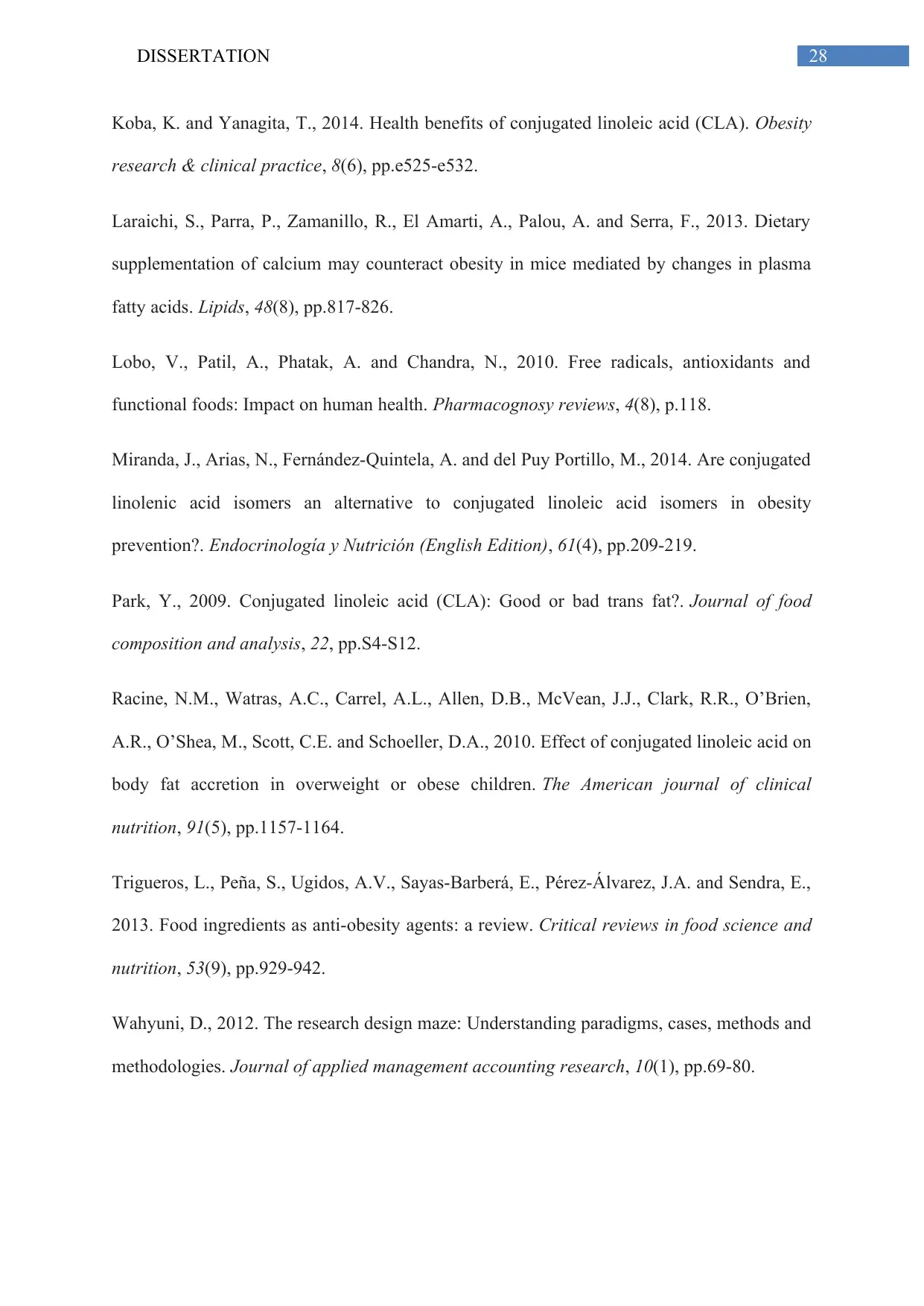
28DISSERTATION
Koba, K. and Yanagita, T., 2014. Health benefits of conjugated linoleic acid (CLA). Obesity
research & clinical practice, 8(6), pp.e525-e532.
Laraichi, S., Parra, P., Zamanillo, R., El Amarti, A., Palou, A. and Serra, F., 2013. Dietary
supplementation of calcium may counteract obesity in mice mediated by changes in plasma
fatty acids. Lipids, 48(8), pp.817-826.
Lobo, V., Patil, A., Phatak, A. and Chandra, N., 2010. Free radicals, antioxidants and
functional foods: Impact on human health. Pharmacognosy reviews, 4(8), p.118.
Miranda, J., Arias, N., Fernández-Quintela, A. and del Puy Portillo, M., 2014. Are conjugated
linolenic acid isomers an alternative to conjugated linoleic acid isomers in obesity
prevention?. Endocrinología y Nutrición (English Edition), 61(4), pp.209-219.
Park, Y., 2009. Conjugated linoleic acid (CLA): Good or bad trans fat?. Journal of food
composition and analysis, 22, pp.S4-S12.
Racine, N.M., Watras, A.C., Carrel, A.L., Allen, D.B., McVean, J.J., Clark, R.R., O’Brien,
A.R., O’Shea, M., Scott, C.E. and Schoeller, D.A., 2010. Effect of conjugated linoleic acid on
body fat accretion in overweight or obese children. The American journal of clinical
nutrition, 91(5), pp.1157-1164.
Trigueros, L., Peña, S., Ugidos, A.V., Sayas-Barberá, E., Pérez-Álvarez, J.A. and Sendra, E.,
2013. Food ingredients as anti-obesity agents: a review. Critical reviews in food science and
nutrition, 53(9), pp.929-942.
Wahyuni, D., 2012. The research design maze: Understanding paradigms, cases, methods and
methodologies. Journal of applied management accounting research, 10(1), pp.69-80.
Koba, K. and Yanagita, T., 2014. Health benefits of conjugated linoleic acid (CLA). Obesity
research & clinical practice, 8(6), pp.e525-e532.
Laraichi, S., Parra, P., Zamanillo, R., El Amarti, A., Palou, A. and Serra, F., 2013. Dietary
supplementation of calcium may counteract obesity in mice mediated by changes in plasma
fatty acids. Lipids, 48(8), pp.817-826.
Lobo, V., Patil, A., Phatak, A. and Chandra, N., 2010. Free radicals, antioxidants and
functional foods: Impact on human health. Pharmacognosy reviews, 4(8), p.118.
Miranda, J., Arias, N., Fernández-Quintela, A. and del Puy Portillo, M., 2014. Are conjugated
linolenic acid isomers an alternative to conjugated linoleic acid isomers in obesity
prevention?. Endocrinología y Nutrición (English Edition), 61(4), pp.209-219.
Park, Y., 2009. Conjugated linoleic acid (CLA): Good or bad trans fat?. Journal of food
composition and analysis, 22, pp.S4-S12.
Racine, N.M., Watras, A.C., Carrel, A.L., Allen, D.B., McVean, J.J., Clark, R.R., O’Brien,
A.R., O’Shea, M., Scott, C.E. and Schoeller, D.A., 2010. Effect of conjugated linoleic acid on
body fat accretion in overweight or obese children. The American journal of clinical
nutrition, 91(5), pp.1157-1164.
Trigueros, L., Peña, S., Ugidos, A.V., Sayas-Barberá, E., Pérez-Álvarez, J.A. and Sendra, E.,
2013. Food ingredients as anti-obesity agents: a review. Critical reviews in food science and
nutrition, 53(9), pp.929-942.
Wahyuni, D., 2012. The research design maze: Understanding paradigms, cases, methods and
methodologies. Journal of applied management accounting research, 10(1), pp.69-80.
1 out of 29
Related Documents
Your All-in-One AI-Powered Toolkit for Academic Success.
+13062052269
info@desklib.com
Available 24*7 on WhatsApp / Email
![[object Object]](/_next/static/media/star-bottom.7253800d.svg)
Unlock your academic potential
© 2024 | Zucol Services PVT LTD | All rights reserved.





